
Support our hydrofoil educational content for free when you purchase through links on our site. Learn more

[2023] Hydrofoil Yacht: The Ultimate Guide to Sailing on Foils
- November 1, 2023
- Hydrofoil Basics
Quick Answer: A hydrofoil yacht is a sailboat equipped with wing-like foils that lift the hull out of the water as it gains speed. This reduces drag, increases speed, and provides a smoother ride. Hydrofoil yachts can be retrofitted on both monohull and multihull sailboats, with different types of foils used for stability and control.
Welcome to Hydrofoiling™, where we bring you all the latest and greatest information about hydrofoil boarding. In this comprehensive guide, we’ll dive into the world of hydrofoil yachts, exploring their history, configurations, classes, and more. Whether you’re a seasoned sailor or a curious beginner, this article will provide you with expert advice and insights into the exciting world of hydrofoil yachts.
Table of Contents
Quick answer, quick tips and facts, background: the evolution of hydrofoil yachts, types of hydrofoil yachts, hydrofoil classes: from moths to ac75, hydrofoil yacht brands and models, advantages and disadvantages of hydrofoil yachts.
- Recommended Links
- Reference Links
A hydrofoil yacht is a sailboat equipped with wing-like foils that lift the hull out of the water as it gains speed. This lifting action reduces the wetted area of the hull, minimizing drag and allowing the yacht to achieve higher speeds. Hydrofoil yachts can be retrofitted on both monohull and multihull sailboats, with different types of foils used for stability and control.
Shopping Links: Check out hydrofoil yacht products on Amazon | Shop hydrofoil yacht on Walmart | Etsy hydrofoil yacht products
- Hydrofoil yachts use foils to lift the hull out of the water, reducing drag and increasing speed.
- Different types of foils, such as T foils, C foils, S foils, and L foils, are used for stability and control.
- Hydrofoil yachts can be retrofitted on both monohull and multihull sailboats.
- The International Moth class is one of the most widespread uses of hydrofoils in sailboats.
- Hydrofoil yachts can achieve impressive speeds, with some reaching over 50 knots.
Hydrofoil technology has been around for over a century, with the first patent for a hydrofoil boat filed in 1898 by Italian engineer Enrico Forlanini. Since then, hydrofoil yachts have undergone significant advancements, transforming the sailing experience and pushing the boundaries of speed and performance.
The concept behind hydrofoil yachts is simple yet ingenious. By using wing-like foils mounted under the hull, these yachts can lift themselves out of the water as they gain speed. This lifting action reduces the wetted area of the hull, minimizing drag and allowing the yacht to glide effortlessly through the water.
Hydrofoil yachts come in various configurations, each designed to optimize performance and stability. Let’s explore some of the most common types of hydrofoil yachts:
Monohull Hydrofoil Yachts : Monohull hydrofoil yachts feature a single hull and employ a “ladder” arrangement of hydrofoils. These hydrofoils typically have a dihedral angle of around 50 degrees and are complemented by a stabilizing rudder foil. This configuration provides stability and control, allowing the yacht to sail smoothly on foils.
Multihull Hydrofoil Yachts : Multihull hydrofoil yachts, such as catamarans and trimarans, offer increased stability and performance. These yachts use wider planforms, allowing for greater lift and control. Some multihulls utilize three foils, with two main forward foils providing lift and a horizontal foil on the rudder for additional control.
Hydrofoil Catamarans : Hydrofoil catamarans, also known as foilcats, combine the stability of a catamaran with the speed and efficiency of hydrofoils. These yachts can achieve impressive speeds while maintaining excellent stability, making them popular choices for racing and recreational sailing.
Hydrofoil technology has found its way into various sailing classes, revolutionizing the way we sail. Let’s take a closer look at some of the notable hydrofoil classes:
International Moth : The International Moth class is one of the most widespread uses of hydrofoils in sailboats. These single-handed dinghies feature foiling capabilities, allowing sailors to achieve incredible speeds and maneuverability. The class has seen rapid growth since 2001, with carbon fiber foils and advanced design techniques pushing the boundaries of performance.
Waszp : The Waszp class is similar to the International Moth class but utilizes aluminum foils instead of carbon fiber. This makes the Waszp more accessible to a wider range of sailors while still providing the exhilaration of foiling.
AC75 : The AC75 is a foiling monohull sailboat class used in the 2021 America’s Cup. These impressive yachts can reach speeds of up to 50 knots, showcasing the incredible potential of hydrofoil technology in the world of competitive sailing.
IQFoil : The IQFoil windsurfer class was selected by World Sailing for the 2024 Summer Olympics. These windsurfers feature hydrofoils, allowing athletes to glide above the water and achieve impressive speeds.
IMOCA 60 : Originally designed as non-foiling offshore racers, the IMOCA 60 class has embraced hydrofoil technology. These yachts now feature S-shaped daggerboard foils, providing partial foiling capabilities and enhancing performance in various conditions.
F50 : The F50 sailboat class is used in the SailGP series and is the first sailboat class to break the 50-knot barrier during a race, with a top speed of 52.2 knots. These high-performance catamarans showcase the incredible speed and agility that hydrofoil technology can offer.
Several brands have embraced hydrofoil technology, offering a range of hydrofoil yachts to cater to different sailing preferences. Here are some notable hydrofoil yacht brands and models:
Gunboat : Gunboat is a renowned brand in the world of luxury hydrofoil yachts. Their models, such as the Gunboat 68 and Gunboat 72, combine performance, comfort, and elegance, providing an exceptional sailing experience.
GC32 : The GC32 is a hydrofoil catamaran designed for high-performance racing. This foiling catamaran offers thrilling speeds and precise control, making it a favorite among competitive sailors.
AC72 and AC45f/AC50 : These hydrofoil catamarans were used in the America’s Cup, showcasing the cutting-edge technology and innovation in the world of hydrofoil yachts. These yachts pushed the boundaries of speed and performance, captivating sailing enthusiasts worldwide.
Nacra 17 and Nacra F20 : Nacra is a well-known brand in the world of multihull sailing, and their Nacra 17 and Nacra F20 models feature hydrofoil capabilities. These yachts offer a perfect balance of speed, stability, and maneuverability, making them popular choices for recreational and competitive sailing.
Hydrofoil yachts offer a range of advantages that make them appealing to sailors seeking speed, performance, and an exhilarating sailing experience. However, they also come with some drawbacks. Let’s explore the pros and cons of hydrofoil yachts:
Advantages:
Increased Speed : Hydrofoil yachts can achieve impressive speeds, thanks to reduced drag and increased lift. This allows sailors to cover more distance in less time, making hydrofoil yachts ideal for racing or simply enjoying the thrill of speed on the water.
Smooth Ride : By lifting the hull out of the water, hydrofoil yachts provide a smoother and more comfortable sailing experience. The reduced contact with the water minimizes the impact of waves and chop, resulting in a smoother ride even in rough conditions.
Improved Efficiency : Hydrofoil yachts are more efficient than traditional sailboats, thanks to reduced drag and improved lift. This increased efficiency translates to better performance and reduced energy consumption, making hydrofoil yachts an environmentally friendly choice.
Disadvantages:
Complex Design : Hydrofoil yachts require a more complex design compared to traditional sailboats. The addition of foils and the associated control systems can increase the complexity of the yacht, requiring more maintenance and potentially higher costs.
Learning Curve : Sailing a hydrofoil yacht requires a certain level of skill and experience. The handling and control of a hydrofoil yacht can be more challenging compared to traditional sailboats, requiring sailors to adapt to the unique characteristics of foiling.
Higher Costs : Hydrofoil yachts, especially high-performance models, can come with a higher price tag compared to traditional sailboats. The advanced technology, materials, and design required for hydrofoil yachts contribute to their higher cost.
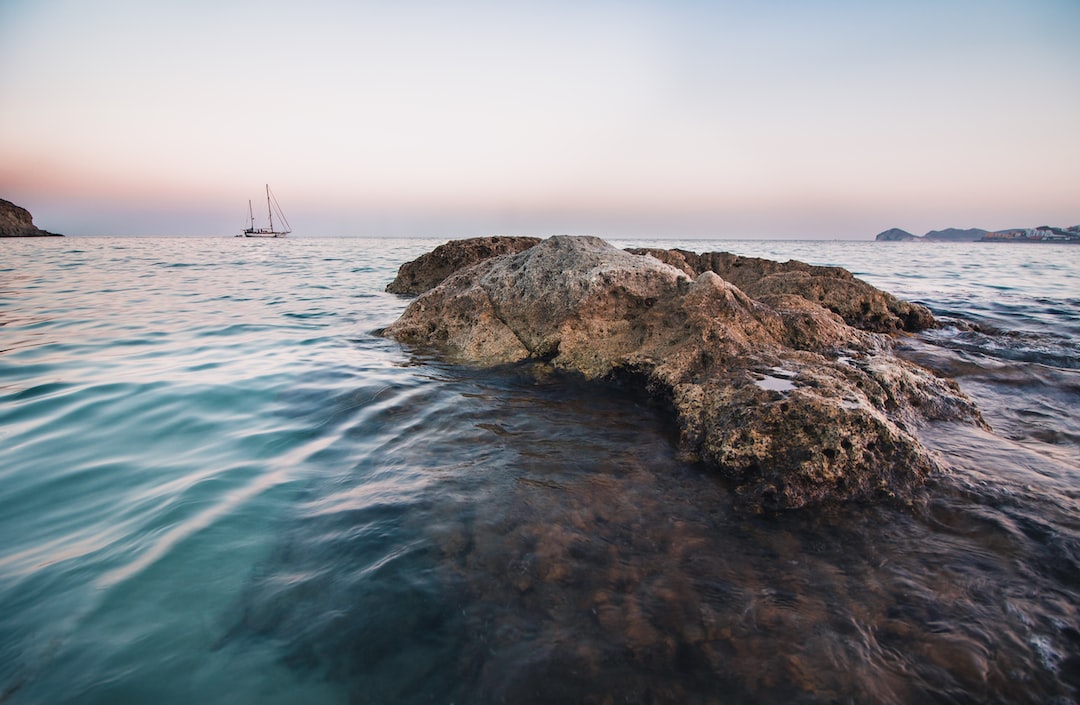
How fast is the hydrofoil racing yacht?
Hydrofoil racing yachts can achieve impressive speeds, with some models reaching over 50 knots (57.5 mph or 92.6 km/h). The F50 sailboat class, used in the SailGP series, holds the record for the fastest sailboat class, with a top speed of 52.2 knots (60 mph or 97 km/h).
What does a hydrofoil do to a boat?
A hydrofoil lifts the hull of a boat out of the water as it gains speed. This reduces the wetted area of the hull, minimizing drag and allowing the boat to achieve higher speeds. The lifting action of the hydrofoil also provides a smoother ride by reducing the impact of waves and chop.
Read more about “… Hydrofoil Catamaran: The Ultimate Guide to Foiling on Water”
How fast do hydrofoil boats go?
Hydrofoil boats can reach impressive speeds, depending on their design and purpose. Racing hydrofoil yachts can achieve speeds over 50 knots (57.5 mph or 92.6 km/h), while recreational hydrofoil boats can reach speeds of 20-30 knots (23-34.5 mph or 37-55.5 km/h) or more.
Why don’t boats use hydrofoils?
While hydrofoils offer significant advantages in terms of speed and efficiency, they also come with certain limitations. The complex design and higher costs associated with hydrofoils can be prohibitive for some boat owners. Additionally, the handling and control of hydrofoil boats require a certain level of skill and experience, making them less accessible to novice sailors.
Read more about “… Why do boats not use hydrofoils?”
Hydrofoil yachts have revolutionized the sailing experience, offering increased speed, improved efficiency, and a smoother ride. Whether you’re a competitive sailor looking for the thrill of high-speed racing or a recreational sailor seeking a more exhilarating sailing experience, hydrofoil yachts provide an exciting and innovative option.
Recommended Links:
- Hydrofoil History
- Advanced Hydrofoiling Techniques
- Hydrofoil Equipment Reviews
- How Do Hydrofoils Work on Boats? 2023
Reference Links:
- Sailing Hydrofoil – Wikipedia
- Gunboat Official Website
- Nacra Official Website
- SailGP Official Website
- America’s Cup Official Website
Now that you have a comprehensive understanding of hydrofoil yachts, it’s time to set sail and experience the thrill of foiling firsthand. Whether you’re racing on the high seas or cruising along the coast, a hydrofoil yacht will take your sailing adventures to new heights. Happy foiling!
Disclaimer: The information provided in this article is based on research and personal experience. Hydrofoiling™ is not affiliated with any specific brand or product mentioned in this article. Always consult with experts and follow safety guidelines when engaging in hydrofoil activities.
Review Team
The Popular Brands Review Team is a collective of seasoned professionals boasting an extensive and varied portfolio in the field of product evaluation. Composed of experts with specialties across a myriad of industries, the team’s collective experience spans across numerous decades, allowing them a unique depth and breadth of understanding when it comes to reviewing different brands and products.
Leaders in their respective fields, the team's expertise ranges from technology and electronics to fashion, luxury goods, outdoor and sports equipment, and even food and beverages. Their years of dedication and acute understanding of their sectors have given them an uncanny ability to discern the most subtle nuances of product design, functionality, and overall quality.
Related Posts
What is the physics behind foiling 10 eye-opening insights to elevate your ride [2024] 🌊✨.
- August 21, 2024
What Propels a Hydrofoil Board? Discover the Secrets Behind 10 Thrilling Aspects [2024] 🚀
What is the physics of hydrofoiling 10 fascinating insights to elevate your ride [2024] 🌊, leave a reply cancel reply.
Your email address will not be published. Required fields are marked *
Add Comment *
Save my name, email, and website in this browser for the next time I comment.
Post Comment
Trending now

Published on June 2nd, 2017 | by Assoc Editor
Foiling and Foil Shapes, a Beginner’s Guide
Published on June 2nd, 2017 by Assoc Editor -->
by Mark Chisnell, Land Rover BAR The rules covering the design and construction of the team’s America’s Cup Class (ACC) boat have defined many of the parts of the boat, including the hull and crossbeams (together called the platform), and the wing shape and size. What’s left for the team’s designers and engineers to work on is principally the daggerboards and rudders, and the control systems that operate them along with the wingsail.
A lot of the technology that goes into the control systems is hidden well inside the hull, with just glimpses of the HMI (human machine interface) that the sailors use to control the board rake, wing trim and so on. The foils are on full view however, so we thought a beginners guide to ACC foil design would come in useful now the racing is approaching.
Basic Principles The foils use exactly the same scientific principles as an aircraft wing. Just as an aircraft wing will lift a plane up off the ground, the foils of an America’s Cup Class boat will lift it out of the water. Wings are foils too, called aerofoils because they work in air. The foils on the new America’s Cup boats are more accurately called hydrofoils, because they work in water.
The secret to both types of foil is the shape – aerofoils and hydrofoils use a special shape to guide the wind or water around them, and generate the lifting force to get planes and boats up in the air. Of course, the America’s Cup boats also use an aerofoil. The main wingsail works exactly the same way as an aircraft wing, it’s just rotated to stand up straight, rather than lie flat.

While an aircraft needs an engine to push the air over the wing fast enough to generate enough force to lift the aircraft up off the ground, the wingsail on the Cup boat generates force from the wind blowing past it. The harder the wind blows, the more force it makes to push the boat forward. When the boat is going fast enough, the hydrofoils will then be able to create enough force to lift the boat out of the water. This reduces resistance to the forward motion and the boat goes faster still.
There are four hydrofoils on the boat — we count the rudders at the back because they have small wings at the tips called elevators. However, the real power to keep the boat in the air comes from the hydrofoils (the daggerboards, as you will often hear them called by the sailors) and we will concentrate on these.
The L-Foil The L-foil is exactly that; a vertical daggerboard shaft that goes through the hull of the boat, with a single horizontal hydrofoil on the bottom, the whole thing shaped like an ‘L’. If nothing else changes, then the L-foil keeps generating lift as the boat goes faster and so the boat keeps rising, and as it rises, less and less of the daggerboard is in the water.
At the basic level, two things then happen: firstly, the boat starts to slip sideways because there is less of the vertical part of the daggerboard in the water and this makes the boat feel unstable and hard to steer. Then, ultimately, if the boat keeps rising the horizontal part of the board that is doing all the lifting will break the surface. If it does, there will be a catastrophic loss of lift and the boat will come crashing back down.
Aircraft use moving parts on the foils to control the amount of lift – trailing edge flaps — but the rules forbid these on the ACC boats, so to maintain stable flight the sailors change the rake or angle of attack of the whole dagger board (and hence the foil) to the water.
Rake If you rake the board backwards as the boat accelerates, the lift will reduce and the boat will come to an equilibrium at a steady height above the water. This is all well and good until the conditions change, maybe the wind speed goes up or down, or the boat hits some waves. When that happens the rake will need further adjustment to find the new equilibrium… until the next puff or lull when it must change again.
In the big breeze and rough water of San Francisco Bay in the 34th America’s Cup it turned out that these moments of equilibrium didn’t last very long and on occasions barely existed at all. The crew’s ability to generate the hydraulic power to change the board and wing trim was simply overwhelmed; they couldn’t achieve stable flight.
V-foil The solution was what’s called the V-foil, in which the horizontal part of the ‘L’ is angled upwards to form more of a ‘V’ shape (the angle at the bottom of the ‘V’ is called the dihedral – a dihedral of 90 degrees would define an L-foil, less than that is progressively more of a V-foil).
The V-foil uses the same principle as one of the most successful original foiling powerboats. The grand old man of 19th century innovation, Alexander Graham Bell put a couple of 350hp engines on the back of what was called HD-4 and set a new marine world speed record in 1919 of just over 70mph.
HD-4 used three ‘ladders’ of small foils, one at the front, and one each side close to the back. When the boat accelerated it started to lift out of the water, and as it lifted, one by one the ‘rungs’ of the foils would break clear of the water. As they did so the lift would decrease, and unless the boat continued to accelerate the boat would stop rising and settle at an equilibrium.
The V-foil achieves this same effect with a single foil and is used in the commercial application of fast ferries— one runs between Southampton and Cowes on the Isle of Wight, right across the Solent waters where the team train, and has done so (on and off) since 1969 – so V-foils are well understood.
When a boat equipped with a V-foil keeps rising as more lift is generated by faster speeds, both parts of the ‘V’ come out of the water together. Critically, when the ‘horizontal’ section starts to break the surface at the tip, it has the effect of reducing the lift gradually, because it doesn’t all come out of the water together. So the boat comes back down gently, working towards an equilibrium ‘ride height’ of its own accord.
It might be that it doesn’t reach this equilibrium before something else changes, but the V-foil has some inherent stability (unlike the L-foil) that doesn’t require human intervention. The shape provides a feedback mechanism to control the amount of lift and produce a more stable ride at a consistent height above the water. The downside of the V-foil is that it will generate less lift and more drag than the L-foil under the same conditions, because some of the lift generated is pushing sideways rather than up.
So one of the big questions facing the teams at the outset of this campaign was whether or not the sailors could achieve stable flight with an L-foil in the new boats and the new venue. Bermuda was a very different place to San Francisco; the winds were expected to be lighter, the water flatter and it seemed that stable flight should be easier to achieve with an L-foil under human control.
A huge amount of work has gone into foil and control system design and we now know that the answer is yes, they can – all the teams are using L-foils, often with unloaded dihedral angles of greater than 90 degrees. These angles close as the boat sails and the foil is loaded up to become much closer to, or 90 degrees.
Cant Another buzz word for the 35th America’s Cup is the cant. The cant of the board is similar to the rake, except that the bottom of the board is moving sideways across the boat, to and from the centreline, rather than backwards and forwards. When the board is canted outwards (towards the edge of the boat) it creates greater ‘righting moment’ and more power to drive the boat forwards.
Righting Moment When the wind hits a sail it creates the force to move the boat forward but it also creates a force that is trying to tip the boat over. If you have ever seen a dinghy or yacht knocked flat by a big gust of wind then you’ve already got the idea.
It’s considerably simplified, but essentially the more force that can be applied to resist the wind’s effort to tip the boat over, then the faster the boat will go, because more of the wind’s energy can be captured and applied to forward motion. The resisting force is called the righting moment and creating as much righting moment as possible is a fundamental principle of designing fast sailboats. It’s the reason that you see people leaning over the windward side when they are racing, putting bodies as far out on the windward side as possible is creating righting moment.
S-Foil Finally, there’s the question of whether the vertical part of the daggerboard should be straight or ‘S’ shaped. The curve of the S-foil could be used — like the cant — to move the bottom of the board outboard and increase the righting moment. So S-foils are more powerful, but they are also more difficult to use. The curves have to raised up and down through the bearings and internal mechanisms in the hull, and that means a lot of work to keep the friction down and the efficiency high.

Tags: AC35 , America's Cup , foiling , Land Rover BAR , Mark Chisnell
Related Posts

America’s Cup: Buckle up, here we go →

New technology for sailing broadcast →

How the crazy idea was born →
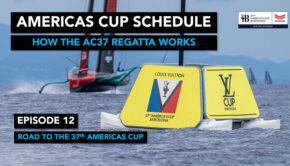
Ep12: Road to the 37th America’s Cup →
© 2024 Scuttlebutt Sailing News. Inbox Communications, Inc. All Rights Reserved. made by VSSL Agency .
- Privacy Statement
- Advertise With Us
Get Your Sailing News Fix!
Your download by email.
- Your Name...
- Your Email... *
- Email This field is for validation purposes and should be left unchanged.

672 Wine Club
- Motorcycles
- Car of the Month
- Destinations
- Men’s Fashion
- Watch Collector
- Art & Collectibles
- Vacation Homes
- Celebrity Homes
- New Construction
- Home Design
- Electronics
- Fine Dining
- Benchmark Wines
- Brian Fox Art
- Chase United
- Disneyland Resort
- Gateway Bronco
- Royal Salute
- Sports & Leisure
- Health & Wellness
- Best of the Best
- The Ultimate Gift Guide
High-Speed Foiling Yachts Are Changing Boating as We Know It. Here’s What It’s Like to Ride One.
From racing sailboats to weekend cruisers, foils represent the industry’s next sea change., michael verdon, michael verdon's most recent stories.
- Jeff Bezos May Be the Owner of a New $80 Million Gulfstream Jet
Rescuers Find Remaining Missing Aboard the Sunken ‘Bayesian’ Superyacht
- President Biden Finally Took the First Flight in the Long-Delayed ‘Marine One’ Helicopter
- Share This Article

Related Stories
- First Drive: This 1968 Mercedes-Benz ‘Pagoda’ SL Is an EV Restomod That’s Better Than the Original
- Acura Is Working on an All-Electric Sports Car to Replace the NSX
- BMW Just Sold More EVs In Europe Than Tesla for the First Time
The F50 is techy, edgy, exhilarating, and, without the right skipper, dangerous. “A hot-rod version of the AC50,” is how naval architect Paul Bieker describes it, referring to the 50-foot catamaran raced in the 2017 America’s Cup , on which this one is based. Bieker’s studio helped design the foils for the America’s Cup boat, but the SailGP design is far faster, having just broken the 60 mph redline, thanks in part to thinner carbon-fiber “L” foils with the same bending stiffness and strength as steel, but at about a fifth of the weight.
It’s hard to understand how powerful these boats are until you’re airborne on one. So enormous is the aerodynamic pressure on the rig that a massive rudder cracks during our training session. “The boat moves fastest by flying as high and unstable as possible,” says Paul Campbell Jones, the U.S. team’s wing trimmer. “The goal is to push the boat to the edge—but if you go a centimeter too far, you either crash or fall off the foils and do a big nosedive.”

It’s high-risk, high-wire sailing at a technological level never before seen, one complemented by the unprecedented athleticism required of the six sailors who pilot the boat—a combination that has helped elevate the sport to a new level.
Campbell Jones has raced on both the AC50 and F50 and says that the evolution is dramatic. “The AC50 didn’t have batteries to lower the foils, so it was seriously more labor intensive,” he says. “We had six sailors on the AC50s and four of them were grinders, turning handles.” The F50, he adds, “is way faster than the AC50, and we can do a lot more maneuvers.”

Standard on the last three America’s Cup fleets and tapped for the upcoming 2024 event, global ocean races and even Olympic windsurfers, foils are changing the rules of sailing. But they’re revolutionizing motorboats, too. In fact, foils can now be found on all sorts of watercraft, from e-foiling boards, jet skis and midsize motoryachts.
“The first foiling powerboat came from Italy and flew in 1906,” says Luca Rizzotti, founder of the Foiling Organization. Alexander Graham Bell’s HD-4 was the second successful attempt in 1918. “But it weighed 5.5 tons and was powered by two Liberty aircraft engines, so was not practical.”
Fast-forward a century with America’s Cup efforts to appeal to the masses with hyper-speed foilers. “Suddenly, the best technology, materials and minds were brought to bear to make these real—in record time,” says Bieker. “The breakthroughs came very fast.”

It’s revolutionizing motorboats, too, according to Bieker. His Anacortes, Wash., firm recently designed foils for the Navier N30, a nine-passenger electric powerboat that glides above the water on three carbon blades, each measuring seven feet five inches.
Where the racing cat delivers raw power, the N30 is about passenger comfort and energy efficiency; think Tilt-a-Whirl versus magic carpet. The foils on the N30 use flaps that adjust 50 times per second, informed by sensors that measure wave conditions. The driver controls speed and steering, but the active foiling system does the rest.

The N30 foils at 15 knots, has a range of 75 nautical miles at 22 knots, and tops out at 35 knots, while three modes (Cruise, Sport, and Economy) match conditions or pilot preference. Navier says the N30 can handle five-foot seas, though during our test ride in San Francisco Bay, we never experienced anything over two feet as we hovered above the chop—minus any sense of wave action—in the sanctuary of the pilothouse version, which will be delivered to its first buyer later this year.
Navier commissioned the respected Maine boatbuilder, Lyman Morse, to build its pilothouse version (it also has a center-console prototype, which was not as well finished). I rode on both during the SailGP finals and it felt so peaceful coasting over the waves, rather than punching through them, while watching the racing.
I was able to drive the pilothouse version a few days later, and the fit and finish was impressive, as was the intuitive response of the foils. The company talks about the similarities with flight, but this felt like boating, just above the waves. The bow and stern thrusters also allow exceptional docking, thanks to the electrical system’s instant response.

On several occasions, the C-8 refused to foil or the foils retracted unexpectedly. A software glitch with the inverter was to blame—an issue resolved remotely by Candela’s headquarters in Stockholm, where 40 of the 200 employees are engineers. But software issues, such as those we experienced, could pose a real problem when boating during off-hours. On the plus side, software also controls safety functions, such as preventing overly aggressive maneuvering and ensuring a return home when the battery is depleted.
Once rebooted, the C-8 turned in a good performance. It’s intuitive to drive and, for an open design, remarkably quiet, with conversation possible even running at speed. I spent about an hour aboard the C-8 and recall flying above one stretch of water, with currents and tides running against each other, that would have battered a conventional boat.

Candela is also making a center-console version of the C-8, which should do well in warm-water areas like Florida. New models will feature Polestar 2 EV batteries that increase range from 40 to 57 nautical miles and have 40-minute fast-charging potential.
Will foiling powerboats become mainstream?
Candela, the only builder with a production line, is convinced foiling is the future. High-volume production builders, and even a few superyacht yards, are also experimenting with the innovation. “Designing something that flies is a real technical challenge,” says Bieker. “But foiling uses a fifth of the energy of a similar-sized deep-V powerboat. Rising energy prices might be what tips the scale in their favor.”
Read More On:
More marine.

This Revamped 161-Foot Trinity Superyacht Could Be Yours for $16 Million

Tech Mogul Mike Lynch and 5 Others Are Missing After a Yacht Sinks in Italy

A Fleet of Candela’s Electric Foiling Yachts Is Rolling Out to the Red Sea in 2025

Meet the Wine Club That Thinks Differently.
Receive editor-curated reds from boutique California producers four times a year.
Give the Gift of Luxury
Latest Galleries in Marine

‘La Dea II’ Superyacht in Photos

12 Must-See Yacht Debuts at This Year’s Cannes Fest
More from our brands, what was kamala harris trying to relay with her chloé designer suit at the dnc, diamond sports group reaches deals with nba, nhl, queens of the stone age cancel 2024 tour dates to prioritize josh homme’s health, christie’s first sale at new asia headquarters led by $35 m. monet, the best yoga mats for any practice, according to instructors.

Foiling into the future
- Tech Briefs

Advances in smaller sail and power foiling craft are also becoming interesting and relevant in the marketplace. The cutting-edge technologies needed to achieve the performance targets in these projects require the very best in design and boatbuilding fabrication, and King Marine has recently demonstrated its ability to meet this challenge with its four latest projects being foiling boats.

For example, the recent launch of Roberto Lacorte’s Maxi-sized foiling Flying Nikka represents a huge forward step in applying foiling technology to offshore monohull performance. While the Imoca class yachts have demonstrated the application of monohull foiling in the oceanic passage context, until now no boat had been designed and built in this size range to have a wide range of foiling performance in a non-oceanic setting, such as the Mediterranean.
Here in lighter air conditions the boat’s sailplan must have the power to generate the initial speed needed to overcome drag from the hull and foils, activate the lift forces to elevate the boat clear of the water and sustain stable flight.
Port and starboard moveable appendage arms and foils are needed to achieve and sustain flying performance on both tacks. A T-shaped foiling rudder keeps the boat in proper angle of attack trim for the foils to lift, as well as to steer the boat in both displacement and flying modes.
‘We had nicely clear directions on the concept,’ says principal designer Mark Mills. ‘This boat is more like the mule of the [American] Magic AC team than an AC boat itself. It will enter short offshore races in the Med, not the long offshore races held there and elsewhere.
It therefore needed not only to meet the expectations for high performance, but also meet the safety standards in the racing and rating rules.’ On this point the team at ORC are working hard to get a workable solution for rating the boat, recognising that the VPP has to run in three modes: displacement, transition and flying. Not an easy task, yet one necessary for this and no doubt more foiling big boats racing against more conventional designs in the future.
From yacht racing to sustainable transport

Another remarkable foiling project recently completed at King Marine is a 12.5 metrelong electric foiling catamaran, designed by VPLP from a concept developed by MerConcept. This very interesting design won an award in the powerboat category at the fifth Foiling Awards in Milan. It features innovations derived from offshore racing, in particular technologies relating to foiling and flight management.
With an eye towards high performance in addition to being eco-friendly, this carbon craft is powered by two electric motors, a single foil and two elevator rudders. The flight control system was developed by Madintec, which says: ‘This hydrofoil catamaran is the first boat that really demonstrates our will to transfer technologies from offshore racing to a more sustainable maritime mobility.’
Electrically powered craft of any type have to navigate some tricky trade-offs. Batteries are not light and the more you have the more range and power you may achieve, but also at the price of greater take-off speeds. For this design the boat’s autonomy in power is targeted for a 90- mile cruise at 22kts with a payload of eight people aboard, which is impressive for a boat this size. The protype of this remarkable design has been built at King Marine to the exacting specifications of the project’s design partners.
Mills also explains that the goal was to have early take-off in light air Med conditions and not try for ultimate top speeds, yet performance expectations are for 30kts VMG upwind and 40 knots downwind – exciting indeed. There is a team of six top talent crew aboard.
The foils are designed to flex and have auto-adjust features similar to those seen on TF35s. For a boatbuilder this is an astonishingly complex brief, not just for the complication of building strong component parts of the boat, its appendages and control systems, but also because every kilogram is critical and the physics are simple: every kilogram saved in weight makes the boat take off faster.
For example, the overall length of Flying Nikka is 18.75 metres yet its weight is only 7,570 kg (slightly more than a TP52). Principal designer Mark Mills says for every 100 kg there is a 0.1-knot delay of take-off speed, so this put tremendous pressure on the design team, working with the suppliers and builders at King Marine, to be at their absolute best in achieving target design weights.
King Marine was able to meet this challenge by having a close collaborative relationship with all the various parties involved with the success of Flying Nikka throughout the life of the project. Only in this way were they able to start in June 2021 and finish in May 2022, on time and on budget.
It’s a remarkable achievement given the lingering supply and staffing issues due to Covid and other new issues that arose recently due to the war in Ukraine. The entire team was composed of recognised leaders in their fields including Mark Mills and KND Marine as co-designers; Pure Engineering on structure design; Nat Shaver on foil design; Thiha Win for the wing system and steering concepts; and Michele Malandra for sail design.
Putting the design concepts into action were other team members that included suppliers Cariboni for the hydraulic systems; Donati Racing for electronics; Faro Advanced Systems and Ricadro Bencatel for PLC and flight controls; Gottifredi Maffioli for running rigging; Re Fraschini for foils and rudders; Southern Spars for the mast; KZ Marine custom furlers; North Sails for sails; Platero for the engine system; and Harken for winches and deck hardware.
This remarkable group was led by project manager Micky Costa, internal project manager Matias Bevacqua and hi-tech boatbuilding experts like Pablo Santarsiero, who were tasked with transforming all ideas into achievable plans.
‘This project took 30,000 man hours to complete,’ says Santarsiero. ‘That is more than twice the amount for a typical TP52, which as we know is also a demanding build in carbon where every kilo counts. The spirit of collaboration on this project was amazing and while there was a lot of stress at the beginning we were really pleased at the end when it all came together. There is no better feeling than delivering a project like this to completion with good results at the end.’

Since there was such a strong demand to minimise weight in the build, Santarsiero says they built female tooling for the hull and deck and had no fairing materials – their process of layup and lamination was sufficient to meet the specifications for a raceboat.
Making this possible at King Marine are not only their talented in-house team who have 10 years of experience (since the 2013 America’s Cup) in building high-quality carbon foils, but the tools they use such as the 2.7 x 8 metre autoclave for prepreg composites, the two Eastman prepreg cutting plotters for ultra precision in making precisely what’s needed in the laminate with minimal extra waste, and a Faro arm for measuring, to ensure quality control.
This is in addition to three postcuring ovens of sizes appropriate for multiple applications – 32 x 9 x 6 metres, 26.6 x 8 x 5 metres, and 9 x 8 x 5 metres – two clean rooms for handling pre-pregs, an ultrasonic NDT machine for quality control, CNC milling equipment, a full carpentry shop and specialised storage facilities for sensitive goods like core materials, dry fibre, pre-pregs and dangerous materials.

King Marine has two locations: a boatbuilding facility and a fully-equipped waterfront centre in the old Team New Zealand base from the 32nd Americas Cup. Here is where new boats are launched and sea trials performed to ensure all details are worked through until both builder and customer are satisfied. Flying Nikka was commissioned here in early May.
Flying Nikka’s race plans include the Giraglia Race in June and the Maxi Worlds in Porto Cervo in September. All eyes will want to see how this exciting project will finally perform on the racecourse as a presage towards more boats like this in the future.
King Marine is further establishing its reputation in meeting the demands of foiling technology with new projects planned in other arenas of offshore foiling, such as the very demanding field of the Imoca class. Here the pressure to achieve is extremely high since not only is this a highly-competitive arena, but failure is unacceptable and possibly dangerous, so the build quality has to be at the absolute best.
This is not an unusual circumstance for the team at King Marine, who has a legendary obsession for quality and has been delivering the highest quality in custom high-tech racing yachts for the past 17 years from their base in Valencia, Spain.
Click here for more information on King Marine

- Subscribe Now
- Digital Editions

Best hydrofoil boats: 6 of the most spectacular foiling motorboats money can buy
- Electric boats
- Top stories
Foiling technology has really taken off in the past few years. We pick out 6 of the best hydrofoil boats you can buy right now…
With its roots in the 19th century, foiling technology is as old as the hills, but in the past five years we’ve noticed an explosion of hydrofoil boats coming onto the market.
In part inspired by the foiling raceboats of the America’s Cup , the popularity of foiling is easy to understand – fuel efficiency gains are substantial, noise is almost eliminated (particularly if your foiling boat also happens to be an electric boat ) and they look as cool as a snowman in a freezer!
To help you understand the dizzying array of foiling boats available right now, we’ve put together the following guide to what we think are the most promising designs out there.
6 of the best hydrofoil boats

SEAir foiling RIB
Founded in 2016, French yard SEAir builds foiling RIBs, having been inspired by the speed of foiling racing yachts.
We tested their 5.5m model back in 2018 and since then they have expanded their range to cover superyacht chase boats, commercial and military vessels.
Our tester recorded a top speed of 32 knots, with the foils doing their best work at around 20 knots, but SEAir claims that 42 knots is possible in the right conditions.
Read more about the SEAir foiling RIB
Article continues below…

Spirit Yachts launches spectacular long-range electric flying boat
BMW launches new ICON electric boat at Cannes Film Festival
The Cannes Film Festival has seen the launch of the new ICON electric boat. Created by BMW in collaboration with

A dual helm set-up allows the boat to be piloted from the bow or the cockpit. Photo: Guillaume Plisson
Enata Foiler
Dubai-based Enata Marine added a healthy dose of glamour to the world of foiling boats in 2018 with the launch of its Foiler.
In addition to a superyacht tender-worthy exterior, this 32fter includes a bow window for spectacular views while underway.
A 40-knot top speed and a 190nm range makes this a very appealing option, although the premium price tag of $938,000 may put some off.
Read more about the Enata Foiler

Princess R35
When British boatbuilding giant Princess Yachts got in on the foiling boat game in 2019 with a 35ft carbon-fibre dayboat, we knew that things had really taken off.
While the foil-assisted R35 may not have the spectacular cruising-above-the-waves appeal of some other foiling boats, it is highly efficient, beautifully designed (in collaboration with Pininfarina) and handles like nothing else we’ve ever driven.
In our review, we praised its rare combination of agility, refinement and stability, with spray kept in check impressively at high speeds.
Read more about the Princess R35

The foiling Candela C-8 is the first boat to use Candela’s proprietary C-POD, but bigger craft will follow later
Candela C-8
Swedish firm Candela burst onto the scene in 2021 with its debut, the Candela C-7 , which was billed as the world’s first electric foiling boat, but it was the 2022 launch of the Candela C-8 that really moved the game on.
Available with a 69kWh battery, adapted from the Polestar 2 electric car, owners can expect a range of 57nm at 22 knots, more than enough for dayboat use.
The consumption figures are truly staggering, with Candela’s figures suggesting that the C-8 is more than 12x more efficient than an equivalent 300hp outboard powered sportsboat.
Read more about the Candela C-8

The electric Iguana is capable of three knots on the land and 30 knots at sea
Iguana Foiler
Not content with being at the forefront of the amphibious boats market with its caterpillar-track offering, French yard Iguana has set its sights on the world of foiling too.
Announced last year, the Iguana Foiler will be powered by the world’s most powerful electric outboard engine, the 300hp Evoy Storm .
Having tested both the engine and the boat separately, we can’t wait to see the result when they come together with the added advantages of foiling technology. Watch this space…
Read more about the Iguana Foiler

The foils lift up at slow speeds to reduce the draft
Mantaray M24
Another exciting model in the hydrofoil boats pipeline, this 24ft runabout is particularly interesting is its simplicity. Unlike its main foiling rival, the Candela C-7, the Mantaray M24 requires no complicated electronics to ‘fly’.
Instead it uses the builder’s patented mechanical hydrofoil system, which it has trademarked as Dynamic Wing Technology or DWT. The technology is said to be the result of ten years’ development work and uses a retractable T-foil in the bow and H-foil amidships that self-stabilise mechanically.
This allows it to lean naturally into corners and ride serenely over waves without relying on a network of sensors and algorithms to monitor and adjust the foils. If it proves effective this could drastically reduce the cost and complexity of foiling boats, while simultaneously increasing reliability.
Read more about the Mantaray M24
It doesn’t end here, with fascinating one-off projects from Spirit Yachts and BMW on the water, it’s clear that foiling has a huge potential for transforming the world of boating.
Read more about hydrofoil technology
Grand Banks 62 first look: new yacht set to launch in 2025
New boats at cannes boat show 2024: pershing gtx80, new boats at cannes boat show 2024: wilder 60, latest videos, watch: parker sorrento sea trial: 50-knot cruiser with a killer aft cabin, watch: virtue v10 sea trial: €272k weekender, how to mark your anchor chain: 6 top tips from our expert, watch: galeon 560 fly sea trial – the best galeon flybridge you can buy.

Berthon Winter Collection

Latest issue

August 2024
In the August 2024 issue of Yachting World magazine: News Few finish a tempestuous Round The Island Race European rules are eased for cruising to France and Greece Olympic sailing…

Yachting World
- Digital Edition

What will foiling do for you? Why foils will change sailing forever
- Matthew Sheahan
- February 15, 2016
Is foiling here to stay, or is it simply a spectacular means of making pro racers go fast? Matthew Sheahan looks into the rapid development of foils and asks what’s in it for us?
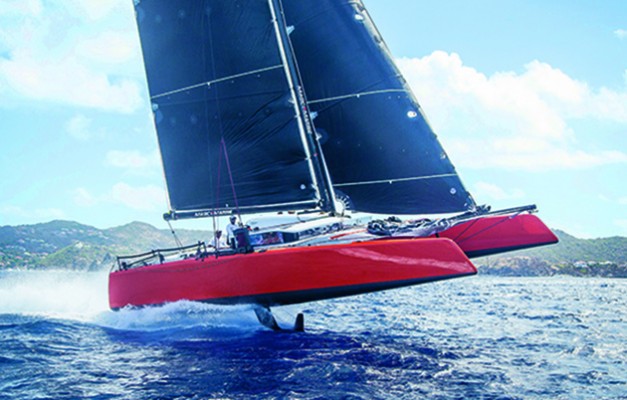
Photo: JesusRenedo / SailingEnergy
“There’s nothing new in what we’re trying to do with foiling America’s Cup boats,” says Land Rover BAR’s head of engineering, Dirk Kramers. “The Wright brothers would have understood the physics of an AC45f, they just wouldn’t have been able to build it.”
He has a point. The basic principles of lift, drag and flight have been known for over 100 years and if there’s one thing that the experts all agree on, it’s that nothing has changed in the physics. Yet the rapid growth of the new foiling watercraft generation has been one of the biggest modern breakthroughs in sailing.
Driven initially by the International Moth, boat speeds have more than doubled in one leap of technology. But apart from the speed, perhaps the most exciting aspect is that some of the technology involved is heading downstream towards the rest of us.
The Formula Whisper foiling catamaran, which we looked at in the August issue, is a good example of how the Moth’s T-foil configuration has helped to create a foiling boat that can be sailed by club sailors rather than pros.
Then there’s the plug-in foiling kit for the standard Laser that promises foiling for all aboard a stable, well-known platform.
At the other end of the scale the move to hydrofoils in the America’s Cup has led to a huge leap in performance since the last Cup match in San Francisco in 2013, with some of the top teams already hitting 30 knots upwind and well over 40 downwind with their 45ft development boats.
And while the teams all seem a little shy about stating how fast they expect to be going in 2017, no one will mock you if you suggest that 50 knots is possible.
Will the technology filter down?
So while there is plenty of development in foil technology in the racing side of the sport, there can be no doubt that it is the big budgets and large design teams made possible by the Cup world that are currently driving the foiling revolution.
But will the lessons learned from this hotbed of development filter down to the rest of us? And if so how?
There are plenty who believe that the answer is yes, but point to aspects of the new technology other than pure speed as being the future benefits. Although the focus for Cup spectators has been the speed, control is where the biggest steps have been made recently: control of the foils to provide smooth, stable flight; control of the boat through tacks and gybes as the entire boat continues to fly above the water’s surface; and control of speed changes, heading and trim without performing a dramatic bows-up wheelie at the leeward mark. Indeed, it is mastering control that many experts believe will win the America’s Cup in 2017.

© ACEA / Photo John von Seeburg
But before we get carried away with the idea that the Cup boats will provide all the answers, it is important to consider that there are other ways to exploit the benefits of high- performance foils. One person who knows this well is world speed record holder Paul Larsen.
“When you’re looking at how foils can increase performance, it is the relationship between power and drag that defines top speed,” he says. “If you opt to reduce the drag by lifting the boat out of the water you can increase speed. Alternatively, you can increase speed by keeping the drag the same and increasing the power generated by the foil.”
It is this latter approach that was one of the cornerstones of Larsen’s success with Sailrocket 2 . When he set the new outright speed record of 65.45 knots there was not much of his bright orange machine touching the water other than the hooked foil to windward and the T-foil rudder at the stern. The key was to grip the water efficiently and use the main foil to generate power rather than using it to lift the boat above the surface.
“If you keep reducing drag you end up running out of righting moment,” he explains. “For example, in high performance dinghies like the 49er you end up having to bear away further in the breeze or twin trapeze deeper downwind to stay upright. After that you need heavier crew just to generate more righting moment for more power. It is why the foiling Moth and A Class cat classes, among others, are starting to see heavier sailors aboard.”
It’s not all about speed
But even the sailing world’s fastest man doesn’t think that outright speed is necessarily the answer. His view of the future for offshore foils envisages faster ocean passages, not just for stripped-out, record-breaking machines, but for vessels carrying a payload.

Photo: Helena Darvelid
“It’s like jets on commercial aircraft,” he says. “Sure we’ve had the technology to travel supersonic for some time, but the biggest benefit to most of us is being able to fly above the weather. This has resulted in reliable schedules and efficient travel. The same could be possible with modern offshore foils that allow us to travel fast enough never to have to sail in bad weather.”
Others have also seen the benefit of using a foil to generate more power. Most recently some of the latest IMOCA 60 boats have fitted wild-looking foils shaped like giant sabres with winglets that protrude from their topsides like the spurs on the wheels of a Roman chariot.

With these boats the thinking is that, instead of lifting the boats out of the water, foils are used to increase power by generating more righting moment. But problems aboard some of the IMOCAs during the recent Transat Jacques Vabre race suggest that maybe these foils are generating more power than teams expected and have overloaded the structure elsewhere in the boat. Others are concerned that the additional righting moment will overload the one-design mast that the class has now adopted.
The Dynamic Stability System (DSS)
But amid the rapid development in grand-prix racing classes, there is one system that is far from experimental. The Dynamic Stability System (DSS) has been increasing righting moment and boat speed successfully – while also creating a better motion – for ten years across a wide range of boat types and sizes.
The system is based on a horizontal foil that is deployed on the leeward side. As the boat picks up speed, the foil produces vertical lift, which increases the righting moment of the boat and hence power. However, the system also serves to dampen down the pitching moment, making for a more comfortable ride.
“There is no question that DSS can not only improve performance, but it can have a big effect on the motion of the boat as well,” says Gordon Kay of DSS. “And it’s not just performance boats that benefit. Any offshore sailing where reaching and running is important can benefit from this system, so for trips like the ARC rally it’s ideal.”

Since Team New Zealand managed to get its 72ft Cup boat up on foils making cats fly has appeared easy. Suddenly, a rush of classes that could fly appeared on the scene: boats such as the Flying Phantom, the Nacra 20f, the A Class and C Class cats and the GC32, to name just a few. Last year even a 40ft performance cruising cat strutted around on foils as Gunboat’s G4 took to the air early in 2015.
However, keeping these cats in stable flight has proved less straightforward. Among the admittedly impressive flights were some spectacular and worrying crashes. As any foiling dinghy cat crew will confirm, scorching around at double-figure speeds is great until it goes wrong.
Safely on the boil
So keeping the machines safely on the boil has been one of the biggest issues. The problem is class rules can often prevent designers from using forms of automatic feedback such as those used on the Moth in which ride height is fed back mechanically to adjust a flap on the trailing edge of the T-foil on the daggerboard automatically.
America’s Cup rules do not allow such systems. Instead the foils, which are a part of the lifting daggerboard system, can only be adjusted by raking the daggerboard fore and aft to change the angle of attack of the lifting part of the foil.
The Cup boats that will be launched for 2017 – along with their current development boats – are allowed to cant the boards inboard from the vertical as well, which helps to control the ride height. “If the rules were taken away we would eventually be able to create a better boat,” says Kramers. “There is nothing new in the physics book, it’s how you control the various systems that’s the key.”
In the previous Cup the rules strictly prohibited changing the angle of attack of the T-foil rudders during the race. Teams had to decide what setting they wanted for the conditions and then lock the angle of attack. In simple terms this was akin to setting the trim of an aeroplane for pitch before take off and then not adjusting again for the whole flight in the hope that conditions would stay the same.
Such strict rules led to some nerve-racking moments for crews when conditions changed during the race.
Since then the rules have been relaxed and teams can not only adjust the rake of the T-foil on the rudder while racing, but its rake can be related to the angle of the main daggerboard foil – or ‘mapped’ to it, as the techies like to say.
This is one of the key changes that have allowed the new generation to foil more steadily and, many hope, more safely. This is good news for the rest of us as this is exactly the kind of technology that will be required for mainstream foiling if it is ever to filter downstream.
Keeping a balance
But the improvements have gone further. Canting the J section daggerboards inboard allows the lower section of the daggerboard and the tip on the other side of the J to act like a V section foil, which helps the boat to find its own ride height as the immersion of the V varies with the speed of the boat.
More daggerboard cant means better automatic ride height control, but this reduces the amount of sideways force the foils can exert and hence risks the cat slipping sideways if it has risen too high with too little foil in the water.
So a fine balance is required when adjusting the highly loaded boards and to achieve this means using hydraulics rather than ropes, blocks and cleats. Yet on some occasions it is the number of operations as well as the fine control, that require a more sophisticated control system.
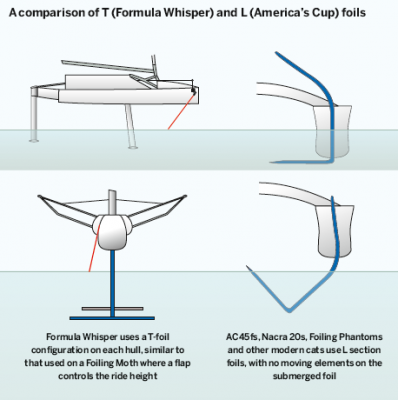
“During a tack or a gybe all four foils [two daggerboards and two rudders] will be adjusted. That’s a lot to ask of a five-man crew, but also a lot of hydraulic oil that needs to be pumped around the circuit,” says Grant Simmer, Oracle Team USA’s chief operation officer. “A crew’s output is about 400W each and in a crew of six we’re using all of that most of the time to drive these boats.”
Seeing the physical demands on the crew and their work rate, which is higher and more sustained than in any previous Cup, drives home just how much power would be required to drive a foiling racer-cruiser of the future.
Looking to the skies
But the development of control systems doesn’t stop with simply moving the foils. The new sophisticated systems also affect the design of the foils themselves. “Without the new control systems we would have to design more conservative and forgiving foils, which are slower,” declares Kramers.
Just as modern fighter jets are more manoeuvrable because they have fly-by-wire systems that operate beyond anything that could be achieved by manual human input, so Cup boats are faster because of control systems.
Little surprise then that the big guns have turned to experts in other fields to help them in this area. Land Rover BAR has worked closely with motorsport and appointed its CEO from McLaren, while Oracle Team USA has hooked up with Airbus.

Les Voiles de Saint Barths 2015, © Jesus renedo
Gunboat’s foiling G4 cat, which suffered an embarrassing capsize during early trials, is having a new, sophisticated control system installed to allow the boat to be sailed comfortably by just one or two crew.
“The new system will control the main foil and the rudder foils as well as some of the sail controls,” explains Ward Proctor of Marine and Hydraulics, a Helsinki-based company specialising in advanced control systems. “The system will control the fore and aft rake of the foils to keep the boat flying level. The helmsman will have the rudder control within the tiller, but if the boat starts to get outside certain parameters, such as heel or pitch, then the system will automatically lower the boat back down into the water.”
Marine and Hydraulics has a track record of producing sophisticated solutions for a variety of craft, from PLC packages for luxury performance cruisers, to a gimballed saloon aboard a Shipman 63.
Proctor expects the G4 system to be up and running by spring and believes that there could be more to come. “We’ve already had enquiries for a 100ft foiling cat,” he reveals.
Motion damping for cruising
So while the Cup and other prestige racing designs are providing the focus for modern systems, it is projects that don’t have the constraints of class rules that are starting to take the application of new technology forward. All of which makes it easier to see how control systems might benefit more mainstream craft.
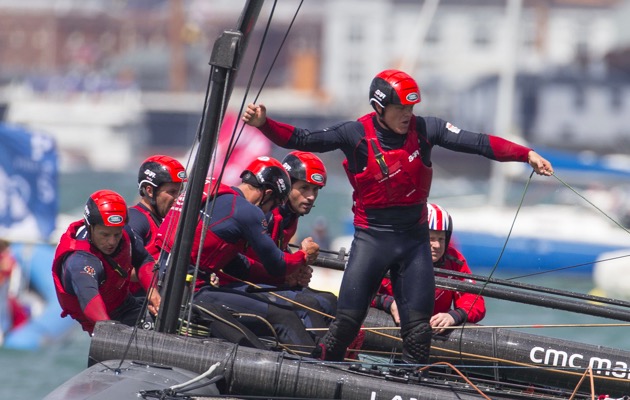
Land Rover BAR in Portsmouth
“Modern electronics and solid state gyros are now readily available and so cheap that electronic control devices could easily be incorporated,” says Andy Claughton, Land Rover BAR’s chief technology officer. “The automatic electronic stabilisers in quadcopters that you can buy in any high street are an example of that.”
Given the ability to sense motion more accurately than ever before, combined with a wealth of electronic processing power and efficient electric motors, the idea of low-drag motion dampers for cruising yachts, similar to those used in powered craft, is becoming more likely.
And perhaps the idea might go even further to allow power to be harvested when the devices were not being actively used. For example, a company called Zehus is producing intelligent hubs for electric bicycles that mean you can charge the internal battery while cycling. When the load on the pedals reaches a critical limit, the electric motor starts automatically to provide assistance.
This small, self-contained unit, which can be controlled via Bluetooth by your smartphone, is already available and being used by some bicycle manufacturers such as Klaxon.
So, when you start to imagine what such systems could do for sailing, automatic motion dampers for cruising yachts are surely only a small step away.
But if motion damping isn’t a prime concern, how about trebling the potential performance of your boat under power by simply fitting a retractable T-foil at the stern?

As we reported in 2013, Andy Claughton’s SpeedSail system offers a means of modifying a boat’s wake to prevent her squatting down at speed under engine while at the same time helping to dampen pitching motion simply by adding a horizontal underwater foil at the stern. Claughton has tested the system at full size and the results are impressive.
Foiling in the future?
So as the world’s most advanced foiling catamarans take huge leaps forward in performance, scorching around in front of thousands of spectators, it is tempting to ask whether we may all be flying in the future. Yet the answer is likely to be no, at least not for family cruising.
And then there’s the cost. Supporting any kind of boat on a horizontal section the size of a tea tray is an expensive business. Cup boat foils cost an eye-watering US$1m a pair, or $500,000 each if you thought the first number was a typing error.
If we’re talking a new generation of section shapes there is little that is going to change for the rest of us. “The book on hydrofoil sections was written 50 years ago. Nothing has changed since then,” says Claughton.
Instead, the real benefit will come with reliable and affordable control systems that will allow us to boost performance for those who want it, while improving the behaviour and motion of our cruisers. Increasing righting moment without increasing displacement using devices such as DSS, along with developments in modern control systems for foils, looks most likely to offer the greatest benefit in the long term for most us.
The genie is out of the bottle. After all, who would now want a car without power steering or ABS?
How fast are we talking?
The 45ft America’s Cup development boats based on AC45 hulls – often referred to as ‘T2’ – are hitting 30 knots upwind and 40 knots downwind.
The top speed so far for the smaller GC32 cats that will be used in the Extreme Sailing Series is 39.21 knots achieved by Alinghi on Lake Geneva while the top dogs aboard the diminutive International Moths are now clocking 36 knots.
How much faster can they go?
Cup teams shy away from talking about specific numbers and, while 50 knots downwind seems possible, many point to the ability to tack and gybe reliably on foils as being the bigger benefit.
Is foiling dangerous?
Opinion is divided here. There is additional risk. Falling off the boat at 40 knots onto water is much like falling out of a car. At these speeds the water feels solid. Being hit by foils is a serious risk, which has already resulted in serious injury.
On the other hand, there are top sailors who say that they are far more comfortable bearing away through the danger zone on foils than they are on a conventional multihull where the leeward bow has a tendency to bury.
Also, once at speed, foiling cats are usually very stable. Turning corners or sailing in big waves can be a different experience though.
Will cruising boats be foiling soon?
For monohulls, foiling in the future is very unlikely. Achieving the kind of power to weight ratio required to fly is very difficult as some of the world’s top, stripped-out race boats are discovering.
Multihulls may be a different proposition as they are better at generating high righting moments without putting on too much weight. But foiling in future will also rely on incorporating either self-balancing foils or automated systems that ensure safe and steady flight. The technology may be there, but at present we’re still along way off a usable solution for mainstream sailors.
How might foil technology affect me?
The Dynamic Stability System (DSS) is a good example of how the smart use of foils can create more righting moment, allowing a stiffer boat that sails more upright with a better motion.
So too are systems like the SpeedSail foil that dramatically improves performance under engine.
Will we go faster?
Generating more righting moment with a system like DSS means more power to start with, but might also mean the weight of the keel can be reduced and lead to a possible reduction in displacement further helping a potential hike in performance.
Could a foil improve cruising comfort?
With the DSS system or perhaps roll stabilisers similar to those used in motor cruisers and ferries, combining efficient, slender foils with modern motion-sensing electronics and powerful small electric motors could see stabilisation make its way onto sailing boats of the future.
The Dynamic Stability System (DSS) also generates more righting moment when the boat is under way. It has been around for over a decade and has been incorporated into a number of designs. The system’s founders believe that the retractable board has benefits for cruising boats as well as racers.
If you enjoyed this….
Yachting World is the world’s leading magazine for bluewater cruisers and offshore sailors. Every month we have inspirational adventures and practical features to help you realise your sailing dreams. Build your knowledge with a subscription delivered to your door. See our latest offers and save at least 30% off the cover price.

THE BOATS: AC75, AC40 & LEQ12
Although foiling feels like a recent revolution to take the world of watersports by storm, it has been at the heart of America's Cup racing for over 10 years.
It was August 2012 when the sailing world was turned upside down by a 72-foot catamaran flying in the Hauraki Gulf. Emirates Team New Zealand had brought foils to the America's Cup, changing the face of top-level yacht racing forever.
Six years later, in 2018, the publication of the AC75 Class Rule marked the beginning of a new sailing era. The engineering and sailing techniques needed to get the AC75 to fly completely differed from anything seen before.
During the 36th America's Cup in 2021, the AC75 proved themselves to be unique and kept millions of fans worldwide glued to their screens. It was then no surprise that the organisers were keen to continue with the AC75 rule for the Louis Vuitton 37th America’s Cup in Barcelona, albeit with several improvements to promote faster flight and incorporate upgraded technology. But the organisers went further. With a focus on youth and women being paramount to growing the sport into the future, a new class of boats was introduced–the AC40–specifically for this purpose. As the smaller sister-ship of the AC75, the AC40 launched in Auckland to much acclaim with speeds hitting the "high 40s" almost immediately straight out of the box under the skillful command of Emirates Team New Zealand in September 2022.

AC75: AMERICA'S CUP BOAT
On the 15th of November 2021, eight months after the Kiwis successfully defended the America's Cup, an updated 'Version 2' of the AC75 Class Rule was released.
The boats will be a step on from what we saw in Auckland in 2021. The foils will be larger to promote quicker lift and faster flight. The boats will be lighter and, onboard, the electronics and software systems will be vastly upgraded. To save weight, the number of crew on the AC75 has been reduced from 11 to 8. The move to reduce the crew means cycle power is again legalised, and the cyclors, introduced by Emirates Team New Zealand in 2017, might return to the game.
Several of the elements are strict one-design, such as the mast, rigging, foil cant-arms and cant hydraulics but the scope for design elsewhere is broad. To keep costs under control, it was also determined that teams would only be allowed to build one AC75 so the demand on getting the design right is at a premium. The boats will be expected to fly at speeds touching 50 knots in winds that average 12 knots in late summers in Barcelona.
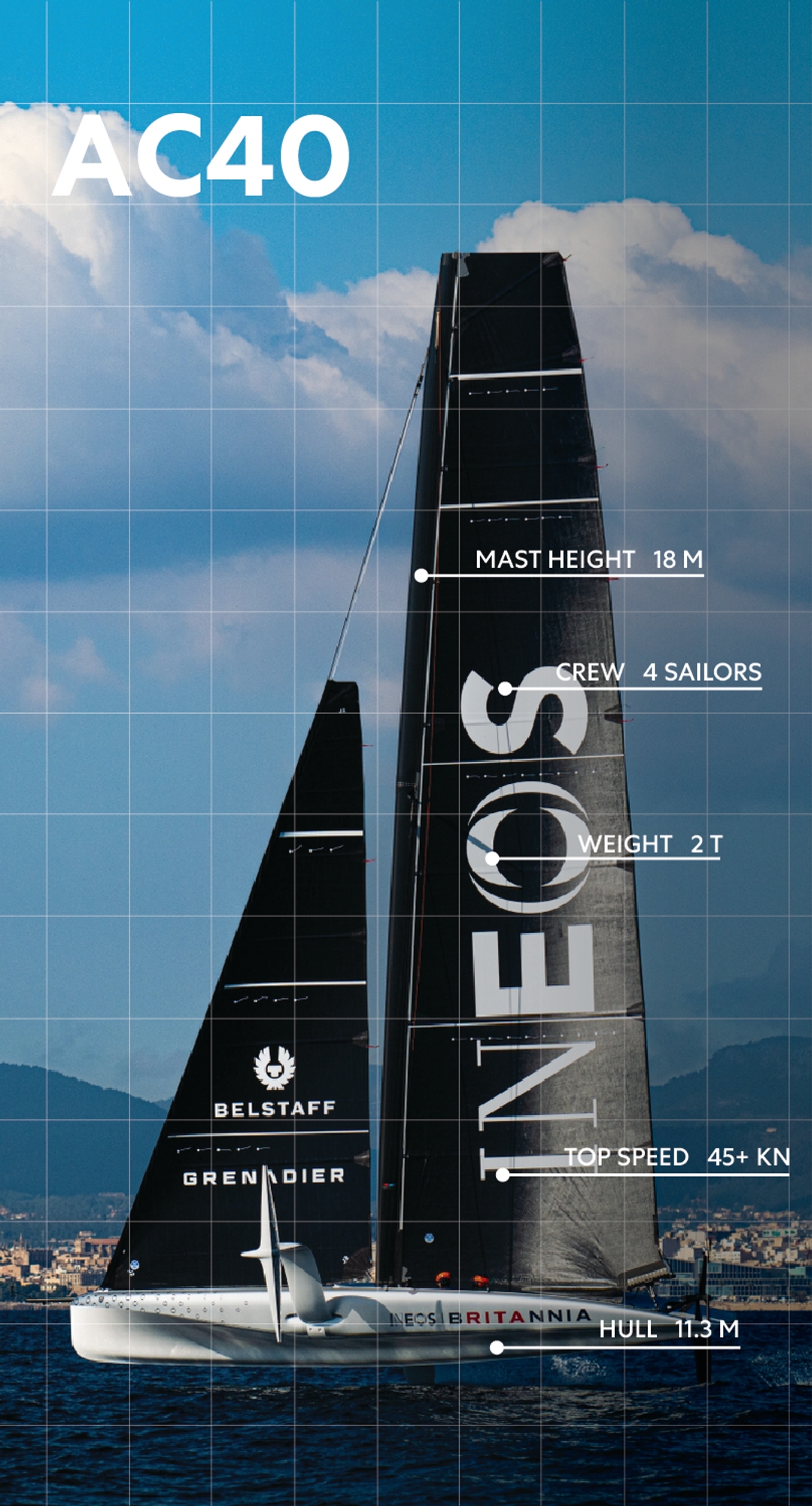
AC40: YOUTH, WOMEN & TRAINING
New for the Louis Vuitton 37th America's Cup, the AC40 is a multi-use foiling monohull that all the confirmed teams will use for sailing and testing purposes. The AC40 is also the nominated boat for both the UniCredit Youth & Puig Women’s America’s Cup events where they will be sailed in strict one-design. The confirmed teams will also use the AC40 in competitive events leading up to the America’s Cup and several of the teams have two boats on order. The AC40 is being built by McConaghy’s in China. The foils and systems are being delivered by the Emirates Team New Zealand North Shore Facility and delivered in strict order of entry to the America’s Cup. Teams may modify and test out componentry on the AC40, and for this purpose, they will be deemed as a LEQ12 (see below), but for competition purposes in the UniCredit Youth & Puig Women’s America’s Cup, they will be returned to one-design according to strict rules around those specific events. Early trials of the AC40 by Emirates Team New Zealand have been sensational with speeds recorded in the ‘high-40-knot’ bracket and it is anticipated that this new class will form a global circuit both before and after the America’s Cup. For the UniCredit Youth & Puig Women’s America’s Cup, aside from the confirmed entries from the America's Cup syndicates, yacht clubs from around the world are being invited to form teams on a strict one-nation, one-entry basis and the finals of the youth and women’s events are scheduled on key dates of both the Louis Vuitton Cup (Challenger Selection Series) and Louis Vuitton 37th America's Cup Match dates.

LEQ12: TESTING ONLY
Entrants for the Louis Vuitton 37th America’s Cup are required to build one AC75 and purchase at least one AC40 but within the rules there is also the opportunity for teams to build one, new, test boat with the stipulation that it must be ‘Less than or Equal to 12 metres in overall length.’ The term LEQ12 was thus coined and it’s a nod to a well used term in computing ‘LEQ’ and was the most accurate description of the vessel. To date, two teams have built dedicated LEQ12s–INEOS Britannia and Luna Rossa Prada Pirelli–and these boats are loaded with sensors, cameras and measuring devices in order that the design team can collate data and calibrate their design software packages in a real-world environment. For the sailors too, it is an opportunity to hone monohull foiling techniques and have the ability to try new sailing styles as well as test new componentry in a relatively controlled environment, and with far fewer consequences than trialling something new on a powerful AC75 at full scale. The two specifically built LEQ12s to date are notably different in design with the Italian LEQ12 being of similar design to the winning ‘Te Rehutai’ of Emirates Team New Zealand during the 36th America's Cup whilst the British LEQ12 is a more extreme design to give a baseline of validation to the INEOS Britannia design team that is supported by Mercedes F1 Applied Science.
How many new AC75s can a team build
When agreeing on the new format for the 37th America’s Cup, the Defender and the Challenger of Record were determined to keep a lid on costs and deliver a sustainable event that could attract additional entries without a very high financial barrier to entry. During the 36th America's Cup, teams were allowed to build two AC75s but in the final Protocol for the 37th America's Cup, it was agreed that teams could only build one AC75 to compete in the America’s Cup in Barcelona. The introduction of the AC40 class allowed for teams to purchase these for either two-boat training or as test boats and a further concession was permitted in that teams could build one specific LEQ12 for testing and training purposes. By implementing the one-boat build rule for the 37th America's Cup, a high premium is placed on getting the final design right as there is little opportunity to change the fundamental design of the boats after launch. The world’s greatest naval architects, designers and engineers have been employed by all the teams with several partnering with complementary sports engineering functions such as Red Bull Advanced Technologies and Mercedes F1 Applied Science. The design race for the Cup is therefore, as intense as ever.
Can older AC75s be used and/or modified?
The first-generation AC75s that were used at the 36th America's Cup in 2021 may be used for training purposes by all of the confirmed teams in the run-up to the Louis Vuitton 37th America's Cup in Barcelona. To date, two teams–American Magic and Alinghi Red Bull Racing–have opted to re-launch these first-generation boats and use them as test boats and in the case of Alinghi Red Bull Racing, the Swiss who were not present during the 36th America's Cup, purchased Emirates Team New Zealand’s first boat ‘Te Aihe’ to train in Barcelona. There are, however, strict rules on developing these first-generation boats with the number of foil wings, flaps, rudders, foil arms, masts, hull surfaces and sails being strictly limited. This could well be the reason why the other teams have elected to develop LEQ12s or to adapt their AC40s into LEQ12s, as is the case with Emirates Team New Zealand, where the limits on componentry and testing are far less stringent, affording more scope for design development and analysis.
When does an AC40 become an LEQ12?
As mentioned above, in relation to the AC40, these boats are delivered in one-design format, but some teams may elect to take them out of one-design to test out componentry, and in this case, those AC40s will be deemed as ‘LEQ12s’ until returned to one-design configuration again. Change anything on your AC40 outside of the very strict class rules on componentry, and it becomes a LEQ12. In order for it to be used in the planned pre-regattas or the UniCredit Youth & Puig Women’s America’s Cup events it must be returned to the agreed one-design. Immediately after the necessary commissioning process of the very first AC40 that was delivered to Emirates Team New Zealand in September 2022, the team made changes to the cockpit configuration and specific controls that the crew use; This immediately converted the Emirates Team New Zealand AC40 to a LEQ12.
Spot the difference

The five IMOCAs in The Ocean Race may represent different design expressions, but the result has been remarkably close racing
To the untrained observer, the five 60-foot high-tech foiling IMOCA yachts competing in the current edition of The Ocean Race may look highly similar in terms of their general design strategies.
But there are subtle differences in how each team has approached the design question posed in creating a boat that will race around the world quickly, safely and reliably.
The rules of the IMOCA class prescribe a set of maximum dimensions – hull length 60 feet / 18.28 metres, length overall (including bowsprit) 66 ft / 20.12 m, draught (depth) 14.76 ft / 4.5 m, and air draft (mast height) 95.14 ft / 29 metres – that create a virtual box within which the designers must make their yachts fit.
IMOCA rules also specify a number of standardised one-design components, such as the wing mast, the outrigger poles and the rigging used to support the mast, the mainsail boom, the fin and the control system of the canting keel – and also specify what hull appendages are allowed: two rudders, one keel, two foils.
No more than eight sails are allowed on board while racing. Other than a ban on the use of carbon and a compulsory requirement to carry a storm jib constructed from heavyweight cloth and coated in a highly visible colour, there are no other limitations on the individual teams’ sail inventories.
According to IMOCA Class measurer Noémie Provost, though, there are few significant sail plan differences across the fleet.
“Given that the mast is a standardised element, the sail plans don’t vary much between teams. Which sails they use and when is more about the strategic routing choices the crews make while racing.
“As an example of that, we saw during the in-port race in Alicante that the 11th Hour Racing Team chose to sail with the J1, while the other boats used the larger JO headsail. This helped the American team to foil a bit earlier than the others in the light wind conditions, because they were less loaded at the bow.”
“We can also see that they tend to use their spinnakers less, because of how quickly the newer generation boats can create apparent wind.
“On the flip side, in the lighter winds of the opening days of Leg 2 GUYOT environnement – Team Europe performed better in downwind VMG mode with their spinnaker.”
As a development class, the IMOCA rule gives designers plenty of scope for innovation and creativity – as evidenced by the hull designs of the five participating yachts in The Ocean Race 2022-23.
France’s three best known yacht designers – either working alone, or in collaboration with each other – are responsible for all five of these yachts.
The legendary Guillaume Verdier worked exclusively with 11th Hour Racing Team, Holcim - PRB, and Biotherm – having previously partnered with Marc Van Peteghem and Vincent Lauriot-Prévost French design house VPLP on GUYOT environnement – Team Europe’s 2015 boat (originally Alex Thompson’s Hugo Boss and then 11th Hour Racing Team’s training and development boat ALAKA'I). Meanwhile, VPLP was chosen by Team Malizia for the design of Malizia – Seaexplorer.
According to Provost the key differences in design thinking across The Ocean Race fleet centre on two aspects: the shape of the bow, and the design of the cockpit area.
It is worth noting here that the only boat that was designed from scratch specifically for fully-crewed racing in The Ocean Race was 11th Hour Racing Team’s Mālama. The other four teams are also planning to race their boats single-handed in the 2024-25 edition of the nonstop round the world race, the Vendée Globe.
As the original fully-crewed IMOCA creation, Mālama’s design process incorporated significant input from the sailing team, who spent copious hours in a wooden mock-up created to simulate the ergonomics of the final boat.
Launched back in 2021, it is important to note the American boat was designed for The Ocean Race’s original pre-pandemic timing and a route around the world that would have featured two additional equator crossings with a stop in Asia.
Back then, Verdier commented that to win The Ocean Race it was very important to have a boat that could perform well across the full range of expected weather conditions.
“It is quite easy to make a boat which is extremely good in one corner of the picture, but we want to be homogenous,” he said. “I don’t really care about being the best boat upwind or downwind – I want the full picture.”
Likewise, GUYOT environnement – Team Europe’s 2015-generation boat also featured a lower narrower bow entry than 2022-gen higher, fuller bow profiles of the Holcim - PRB, Team Malizia and Biotherm IMOCAs.
Team Malizia describe their boat as having a ‘spoon bow’ rather than a true ‘scow bow’ – with what they believe to have better all-round performance characteristics.
Nevertheless, IMOCA’s Provost believes there will be times during the current edition of The Ocean Race when the conditions will favour both 11th Hour Racing Team and GUYOT environnement – Team Europe.
“Mālama still has a lot of volume at the bow even if we don’t recognize a scow bow shape,” she says.
“There could be an advantage for both these teams when there is less wind. When these boats are not foiling – i.e. in Archimedean mode – they still keep a long waterline length and that is directly linked to boat speed – even if this needs to be balanced with the slowing effect of additional wetted surface area.”
The breakneck speeds at which the foiling IMOCAs can now cross open oceans precludes the sailors spending extended periods of time on deck. Instead they race their boats from down below, protected from the elements by a solid coach roof.
According to Provost, as the oldest boat in the fleet, GUYOT environnement – Team Europe stands out as having the most open cockpit – a contrast to the other three, which are almost completely enclosed.
“There are two philosophies on display regarding the configuration of this cockpit area. Team Malizia has opted to have a lot of space, with plenty of headroom, and, unusually, they put the cockpit forward of the crew living space. Meanwhile, Holcim – PRB and Biotherm have kept the cockpit at the back of the boat with a much lower ceiling.”
When it comes to the design of the gigantic protruding foils that enable the IMOCAs to skim, and at times fly above the ocean surface, all five have have opted for the latest generation of so-called ‘Dalí’ foils (named after Salvador Dalí, with a nod to the famous Spanish artist’s iconic moustache).
However, although the foil shapes may look similar at first glance, it is clear that there are subtle differences between them that reflect the individual teams’ interpretation of what is optimal for an around-the-world racecourse.
“It looks like the designs have tended to converge – even if in reality we are still at the beginning of the evolution of ocean racing foil design,” Provost explains.
“The foils that The Ocean Race teams have chosen are a small snapshot compared to the entire range of existing boats and numerous foil configurations.”
Although race rules mandate that teams can only use one set of foils for the entire race around the world, dispensation was granted to 11th Hour Racing Team to swap to a pair of old generation foils after serious damage was discovered at the end of the second leg from Cabo Verde to Cape Town.
Despite all these design differences the relative performance of all five boats over open ocean legs has proved to be surprisingly similar.
Accordingly, die-hard fans of The Ocean Race will have been delighted to discover that the racing has been tantalisingly closely fought on the opening three Legs of the 2022-23 edition with the boats often racing within sight of each other after weeks at sea.
With more than half of the scoring opportunities yet to be contested, the second half of The Ocean Race has potential for surprises and close racing.
Technology : "There is no such thing as the perfect foil" - how airfoils work
Andreas Fritsch
· 25.02.2024
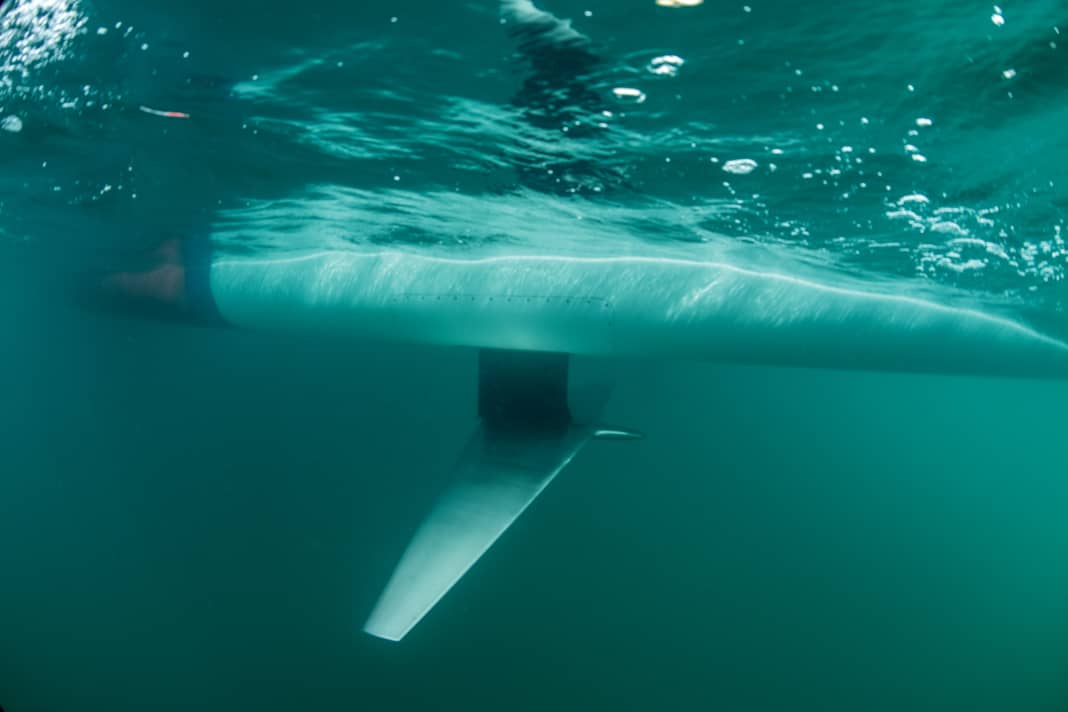
YACHT: The SailGP regatta series recently tested new foils and reported an incredible 15 per cent jump in performance. That seems astonishing, as at the top end of the sport there is often a fight for every tenth of a knot. Is the foil technique still in its infancy so that such huge leaps are possible?
Martin Fischer: 15 per cent is definitely possible. However, they have tested a different configuration, so far these are so-called J-foils, i.e. bent inwards. When the boat is placed on the foil, the vertical lift of the wing, the centre of lift, is inside the hull. So you have a certain righting moment. And this is determined by how far apart the centre of gravity of the boat and the centre of buoyancy of the foil are in a lateral direction. However, the new profiles are T-foils, which are bent slightly outwards. This shifts the centre of lift of the wing outwards and the righting moment increases significantly, allowing more pressure to be applied to the sail. This means that 15 per cent more performance is possible.
If you had stayed with the J-Foil, would there not have been this significant increase?
Exactly. They haven't found a particularly clever new shape that has so much less resistance, but simply increased the power of the boat by ten to 15 per cent. It's as if you were to install an engine with 50 hp more in an existing car.
According to SailGP, the cavitation limit has also been moved upwards by six knots and they now hope to reach 59 knots. Until now, many teams, such as the Imocas or Ultims, have said that above 50 knots is a kind of sound barrier for cavitation ...
In principle, this limit already exists. With a conventional foil, there is one side that has positive pressure and the other has negative pressure. At higher speeds, the negative pressure becomes so great that the vapour pressure of the water is undercut and it evaporates directly on the surface of the profile. This means that part of the foil is no longer working in liquid water, but in water vapour. This leads to a bubble wake, which drastically increases the drag. And if this happens on large parts of the wing, you can no longer go much faster. Typically, once cavitation has started, you can still achieve two or three knots more, but after that it's over. However, it is possible to build foils that only start to cavitate at 60 knots. But then they are pretty bad at lower speeds. An example: If we have a foil that kavits at 40 knots and one that kavits at 50, the one that starts at 40 is faster in the range between zero and 40 knots. And the other foil is then only between 40 and 50 knots faster. So that would be good in a lot of wind downwind, but on all other courses and in less wind the boat would be slower.
Most read articles
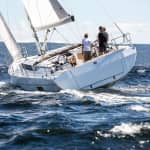
It doesn't matter in the SailGP, these are standardised class boats, they all use the same foil and the race committee decides which one to use. But in the America's Cup, the Imocas or Ultims, the choice is up to the team. In the open classes, you have to think carefully about when cavitation is allowed to start. It is an active design decision.
Different working states of a foil
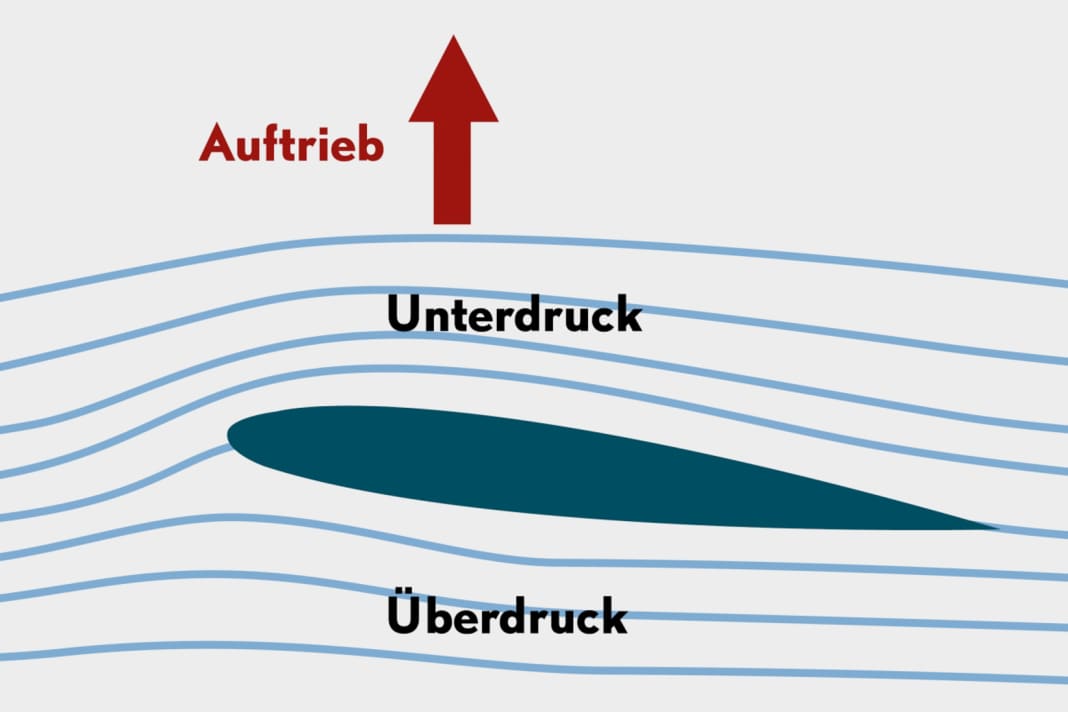
So the idea of the border is basically wrong?
Yes and no. You can have cavitation even at ten knots. It just depends on the negative pressure of the airfoil. Let's take the Imoca foils: they cavitate at around 35 knots. This is done on purpose because an Open 60 doesn't sail any faster, it doesn't fly completely. That's why it makes no sense to use profiles that only kavit at 40 knots, but would be slower from zero to 33. But there is an upper limit. Beyond 60 knots, it becomes difficult not to kavit with a foil designed for use in liquid water. In addition to the high-speed aspect, there is also a cavitation problem at low speeds. If the foil is still to achieve sufficient lift, you have to work with a high angle of attack. Then, even at low speed, you have negative pressure peaks that cause the profile to cavitate locally at the top front even at low speed, which slows you down again.
The difficulty for foils in the America's Cup or SailGP is that with conventional profiles you can cover a speed range of 20 to 25 knots in which the foil does not cavitate at all. And you have to choose this range consciously, and it is difficult to increase. If you want to take off at 20 knots, your speed range without cavitation is 20 to 40 knots. If you want to reach 45 knots, the take-off speed is 25 knots.
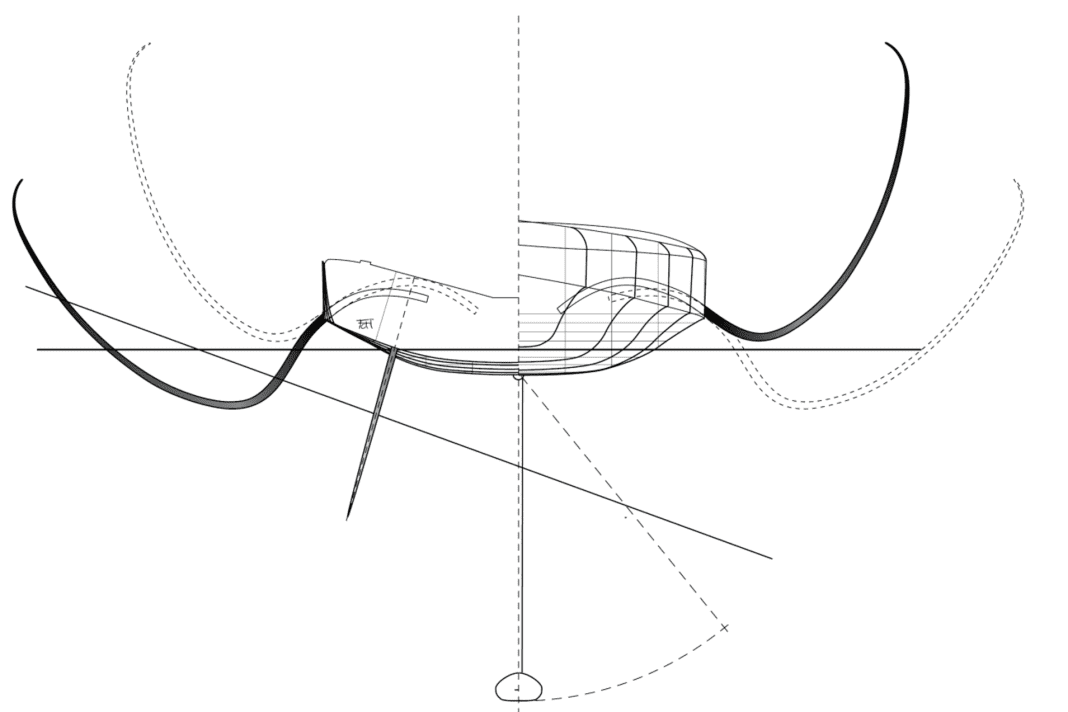
Is it ideal to build as many foil sets as possible?
Actually yes, but in the America's Cup it's forbidden, we're only allowed to use one set of foils. This was done on purpose to keep the costs within reasonable limits, because they are extremely high. SailGP uses more profiles because of the different venues with very different wind conditions, so that the boats fly even in light winds.
How much does a set of foils for an AC boat cost?
One is well over a million euros, and with a reserve foil that's three to three and a half million euros. We didn't want teams to develop extreme profiles that could then lead to very large differences in speed. In that case, it becomes a game of poker: Which foil do I use in which wind? If you get it wrong, it's like driving on wet tyres in Formula 1 when it's dry. It is to be expected that all teams will design more or less all-round foils. That way we will have reasonable races with comparable speeds. This is also indicated by what we see in the tests with the LEQ12 boats: They have all developed in similar, moderate directions.
Isn't the higher weight of offshore boats like the Imocas and Ultims a problem, as they have to be much thicker as a result?
Thickness is always a problem with foils. The cavitation speed is determined by the percentage thickness. This means that a foil that is eleven per cent thick in relation to the chord length cavitates at 48 knots, one that is 16 per cent thick at 38 knots. This is the relative thickness. And of course you want to reduce the wetted surface area. For example, you need to have five centimetres of thickness for strength reasons so that the foil doesn't break. If you then choose a ten per cent profile, that means a chord length of 50 centimetres. At 20 per cent, that means only 25 centimetres of chord length. So it's always about finding the best compromise between the expected cavitation and speed. Fast foils have to be thinner, but the wetted area is larger. This is why Imoca foils are around 14 per cent thick, SailGP foils around ten per cent. But it can be said that all foils, whether Imoca, Ultim, SailGP or America's Cup, are at the strength limit.
Does it actually make a big difference between the Imocas and the other foilers that they don't have T-foils on the rudders? This means they don't fly as stable as an America's Cupper, for example.
Yes, that makes a big difference. The lack of a T-rudder on the Imocas means that the stern sinks when the boat starts to fly. This increases the angle of attack of the main foil, too much lift is generated and the boat shoots out of the water at the front until it stalls on the main wing. The boat crashes down. So you don't achieve stable, long flight phases as with America's Cup, SailGP boats or the Ultims.
In a recent YACHT interview on the launch of the Ultims, Charles Caudrelier said that there will be no T-foils on offshore boats because they only work if they are regulated all the time, which a single-handed skipper can never do, and automatic systems are banned. Is that the case?
Yes, they need foils that regulate their own altitude. The first ones in the America's Cup were also like this, these J-foils. It works like this: There is always an angle between the foil shaft, which is actually always in the boat, and the tip: the tip goes inwards and slightly upwards. If you then sail and the boat flies at a certain height and the foil comes further out of the water due to more speed or a wave, it reduces the surface area of the shaft in the water. As a result, the drift to leeward increases. And the drift reduces the angle of attack of the water at the tip. This causes the foil to lose buoyancy and the boat sinks again. The drift decreases and the whole process is now repeated, but in the opposite direction.
How complex is the regulation with T-foils in the America's Cup in comparison?
This is a full-time job. Typically, one crew member adjusts the angle of the flaps at the end of the foil once a second. The team member concentrates on nothing else. Of course, this is not possible with an Ultim or Imoca.
One would have expected a dramatic improvement in the Etmal with the Ultims, which are fully foiling. Why doesn't the existing mark fall?
On the other hand, the days on which the Tris manage 700 miles have increased significantly. The improvements are more to be found in the average speeds and the control of the boats. For example, the Ultims now all have a T-foil at the bottom of the centreboard in the main hull. This allows the righting moment and the flight altitude to be actively controlled. This means that if the hull sinks, the foil is set to lift and pushes the boat out. If you have too much pressure and perhaps need to open the sheet sooner, you can set the T-Foil to downforce, which then pulls the boat down and immediately increases the righting moment. This is easier with a simple adjustment of the foil than opening the sheets and laboriously tightening them again.
Another question on the subject of cavitation. The imploding vapour bubbles damage the material of the foil. How strong is the effect and how long does it take for the damage to become critical?
This can happen very quickly, not in minutes, but in hours. Temperatures of up to several hundred degrees can occur during the implosion of the vapour bubbles. This damages the material and can cause holes or delamination. For this reason, the foils are designed so that cavitation occurs as far back as possible at high speed, i.e. the implosions start behind the profile.
What actually happens during the high-speed record attempts? The Swiss team SP80 is currently trying to break the record of 65.45 knots set by Paul Larsen's British team Sailrocket in 2012 and has set its sights on getting close to the 80-knot mark. Paul Larsen told YACHT that they have already used "ventilating foils". Now the Swiss are even talking about "super ventilating foils". What does that mean?
A distinction must be made between the two phenomena of cavitation and ventilation. Cavitation refers to the effect when the water on the foil evaporates. Ventilation means that the wing draws in air from the water surface. With a foil that ventilates, the negative pressure side works in air. With a foil that cavitates, the negative pressure side works in water vapour.
The profiles of Sailrocket or now probably also of SP80 pierce the water surface, and at very high speeds cavitation sets in, which leads to ventilation until the foil ventilates completely on the underpressure side, i.e. over the entire surface. You lose the suction effect on the underpressure side, but the overpressure on the other side means that a force is still generated, albeit a smaller one. It is important to realise that the foils on boats work differently: They do not push the boat out of the water, but pull it in, keeping it in the water. In both the Sailrocket and the kite models, the sail pulls the boat strongly upwards. This means that the foil guarantees contact with the water. In the case of Sailrocket, the top worked completely in the air, only the bottom worked in the water. When they didn't have this under control at the beginning, the boat took off and flipped over in the air for precisely this reason.

So what is the advantage of these ventilating foils?
You have no choice, at speeds above 60 knots a foil simply no longer works for liquid water. So you have to make sure that at least the overpressure side is still working. Once you are in this range, there is basically no physical limit to even higher speeds. Such profiles also look very different from foils that are only supposed to work in liquid water. They are very pointed at the front and blunt at the back, almost like a wedge. The problem, however, is that such foils are very poor in the low speed ranges, i.e. from zero to 30 or so. The sail area is rather small for high speed. It took Sailrocket a long time to make this transition under their own steam; they fiddled around at 30 knots for years. When they finally got above 40, they very quickly reached the record of 65 knots.
So far, the fastest sailing boats have been seen in relation to wind speed. The SailGP and America's Cup boats sail somewhere between three and four times the wind speed, the land and ice sailors at six to eight times. What else is there in sailing?
The speed record boats actually have a very poor efficiency factor in this respect. They are more like two to two and a half times the wind speed. That's why they are also dependent on these high-speed wind spots such as the Lüderitz Canal off Namibia or the Mistral wind corridors in the Mediterranean. The factor between wind and boat speed depends primarily on the ratio of lift to drag. If the latter is good, the former is also good. But this ratio is much, much worse with ventilating foils than with normal profiles. A normal foil could achieve ratios of 1:20, a hyperventilating foil is already well served at 1:5.
It's even worse with the surfers. They reach 50 knots in about 50 knots of wind, so the ratio is almost 1:1, which is why you can't make great leaps. And of course, the aerodynamics of a windsurfer are simply miserable due to the rider in the wind, arms outstretched and all. Hydro and aerodynamics play equal roles at speed.
Good keyword: the Ultims have recently seen massive investment in improving their aerodynamics: The trees were given fairings right up to the deck, so-called deck sweepers, so that the end plate effect works to reduce turbulence. How important is this in the America's Cup?
Hugely important. In the Cup, we will see that the boats are all completely optimised aerodynamically. Aerodynamics is almost more important than hydrodynamics. For example, the rudder is optimised from an aerodynamic point of view. It comes out of the water with the shaft when foiling. The part is then optimised for air resistance, not water resistance.
About the material of the foils: the new ones on the SailGP are now made of titanium instead of carbon fibre, while the Imocas and Ultims are elaborate laminates made of hundreds of layers of carbon fibre. Construction is so expensive and time-consuming. What about the Cup?
The foils really take ages to build, one takes months. They are milled from steel, which means they can be even thinner. This is high-strength steel that has to be specially forged and treated. Milling then takes a very long time as the steel is extremely hard.
There are many sources of error when laminating carbon fibre foils: Resin content, air pockets, contact pressure. Is it much easier with steel?
Exactly. With metal, the risk of something going wrong is much lower.
Let's keep our fingers crossed that this Cup will be more exciting and closer than last time.
We would prefer it not to be exciting. If we dominate so much that the others have no chance, that would be okay with me (laughs). England have been trying to win the Cup for 170 years, it's about time!

Other interesting foil articles:
- "FLYINGNIKKA": On board the 60-foot foiler - "like a GT sports car"
- LA BOULANGÈRE MINI-TRANSAT 2023: Federico wins, the foilers lose
- BALTIC 111: "Raven" achieves 29 knots with foils at the first attempt
Most read in category Yachts

CLASS CULTURE
THE JUNIOR FOILER
SAILGP PARTNERSHIP
Buy a waszp.
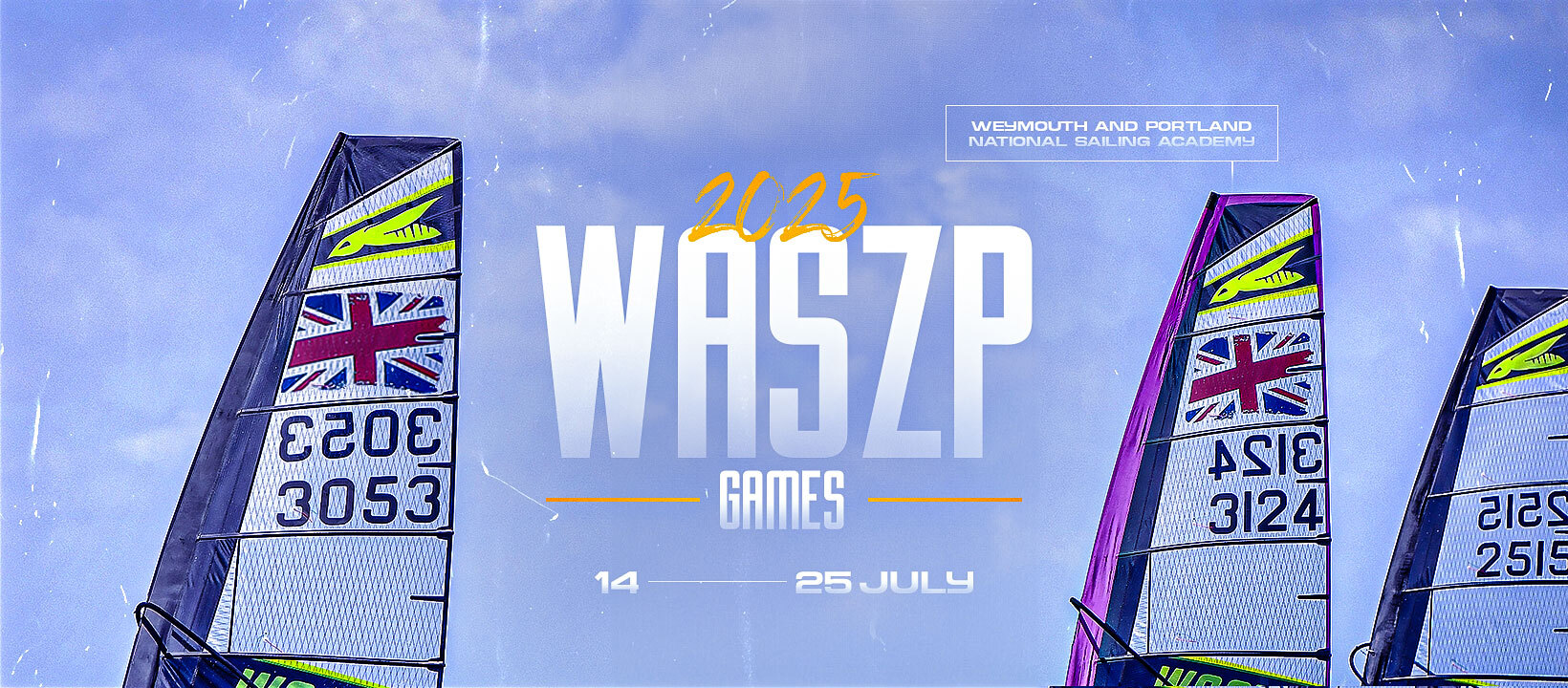
Latest News
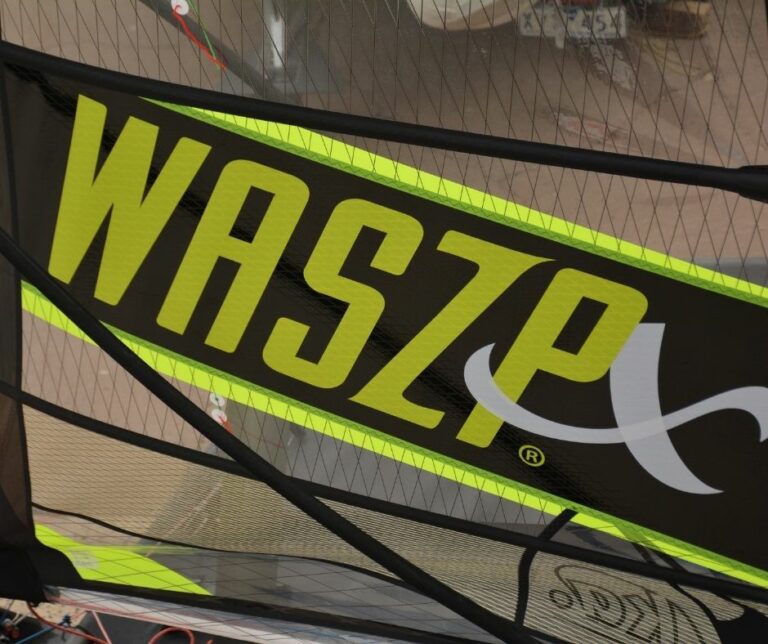
NEW Product – The WASZP_X – The Ultimate Junior Foiler
Launch – VIDEO: On the back of the extremely successful 2021 European WASZP Games and return to international competition,...
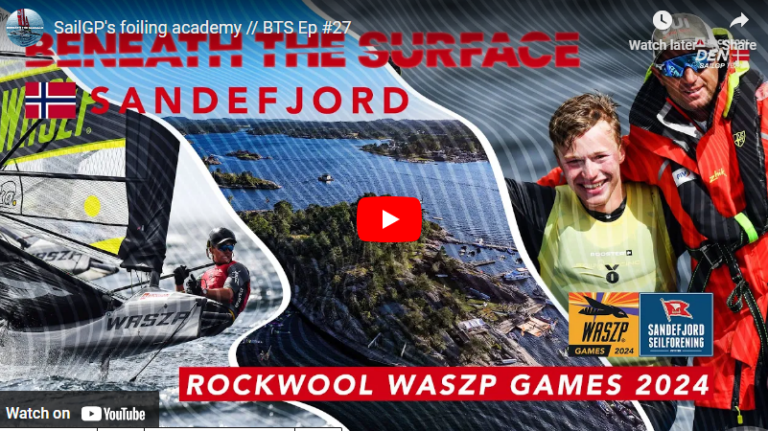
SailGP’s Foiling Academy – Beneath The Surface
Have you ever wondered where the next generation of SailGP foiling superstars are made? Join us in Sandefjord, Norway...
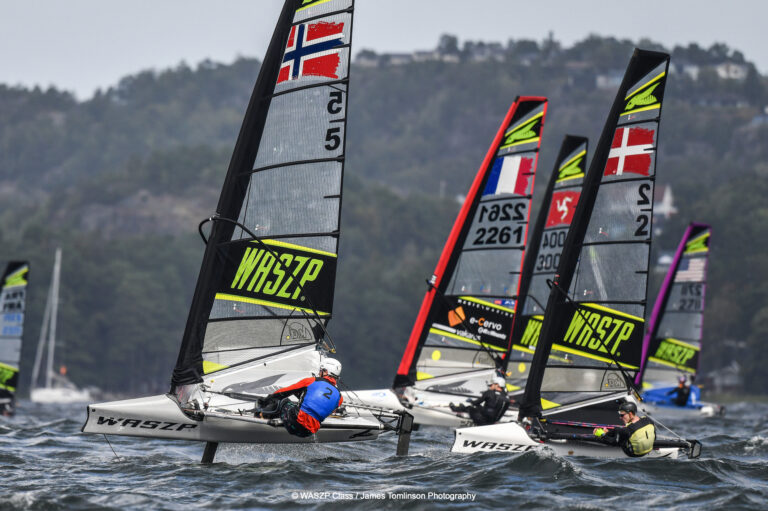
Denmark’s Magnus Overbeck Secures Title at 2024 International WASZP Games
After a week of high-intensity racing at the 2024 International WASZP Games, Danish sailor Magnus Overbeck of the KDY...
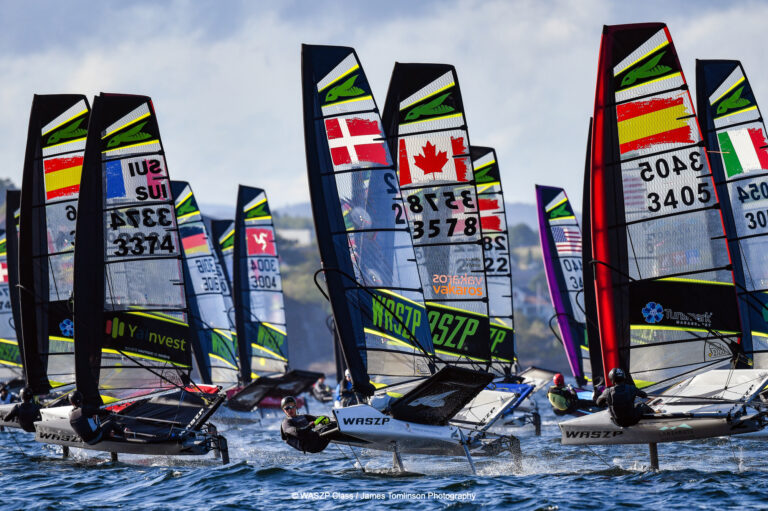
Wet and Wild Finals at the 2024 International WASZP Games in Sandefjord, Norway
Sandefjord, Norway – The penultimate day of the 2024 International WASZP Games brought a dramatic shift in conditions, challenging...
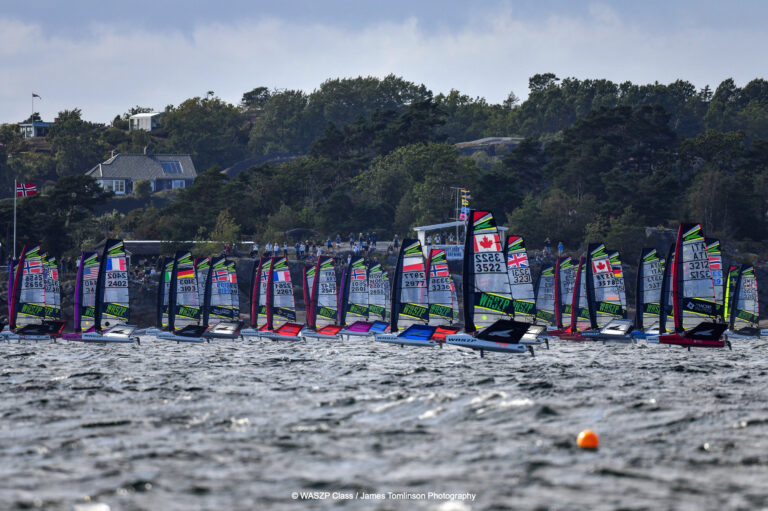
Epic Racing at the 2024 International WASZP Games – A Day to Remember
Sandefjord, Norway – August 9, 2024 The third day of the 2024 International WASZP Games delivered one of the...
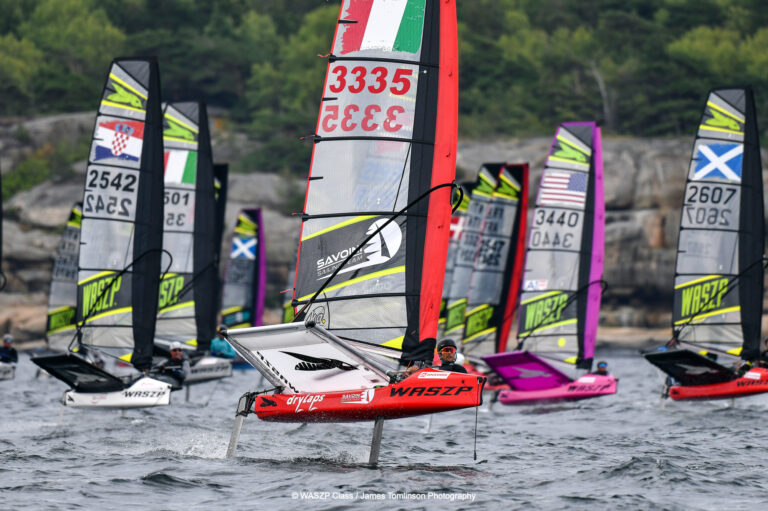
Botticini Hits the Lead as Fleet is Finals Bound
Sandefjord, Norway The second day of the WASZP competition in Sandefjord saw moderate conditions and a reasonable sea state...
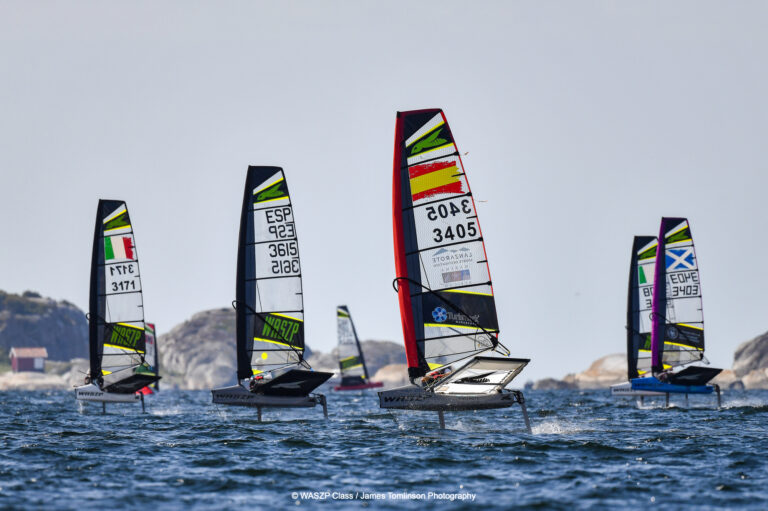
Sunshine and Strategy Define the Opening Day of the 2024 International WASZP Games in Sandefjord
Sandefjord, Norway — The highly anticipated 2024 International WASZP Games commenced under perfect conditions, with sunshine and flat water...
SUBSCRIBE TO WASZP NEWS

Join the Swarm!

NUMBER OF COUNTRIES
Fastest speed @jackson macauley, boats entered @ waszp games 2024.
TESTIMONIALS
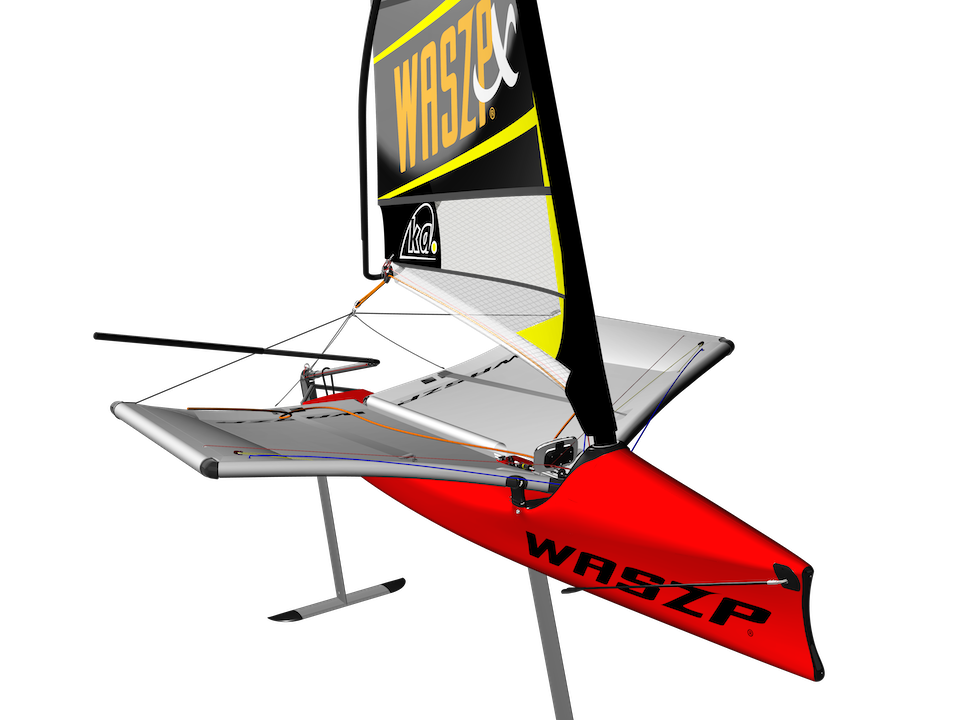
SAILGP INSPIRE
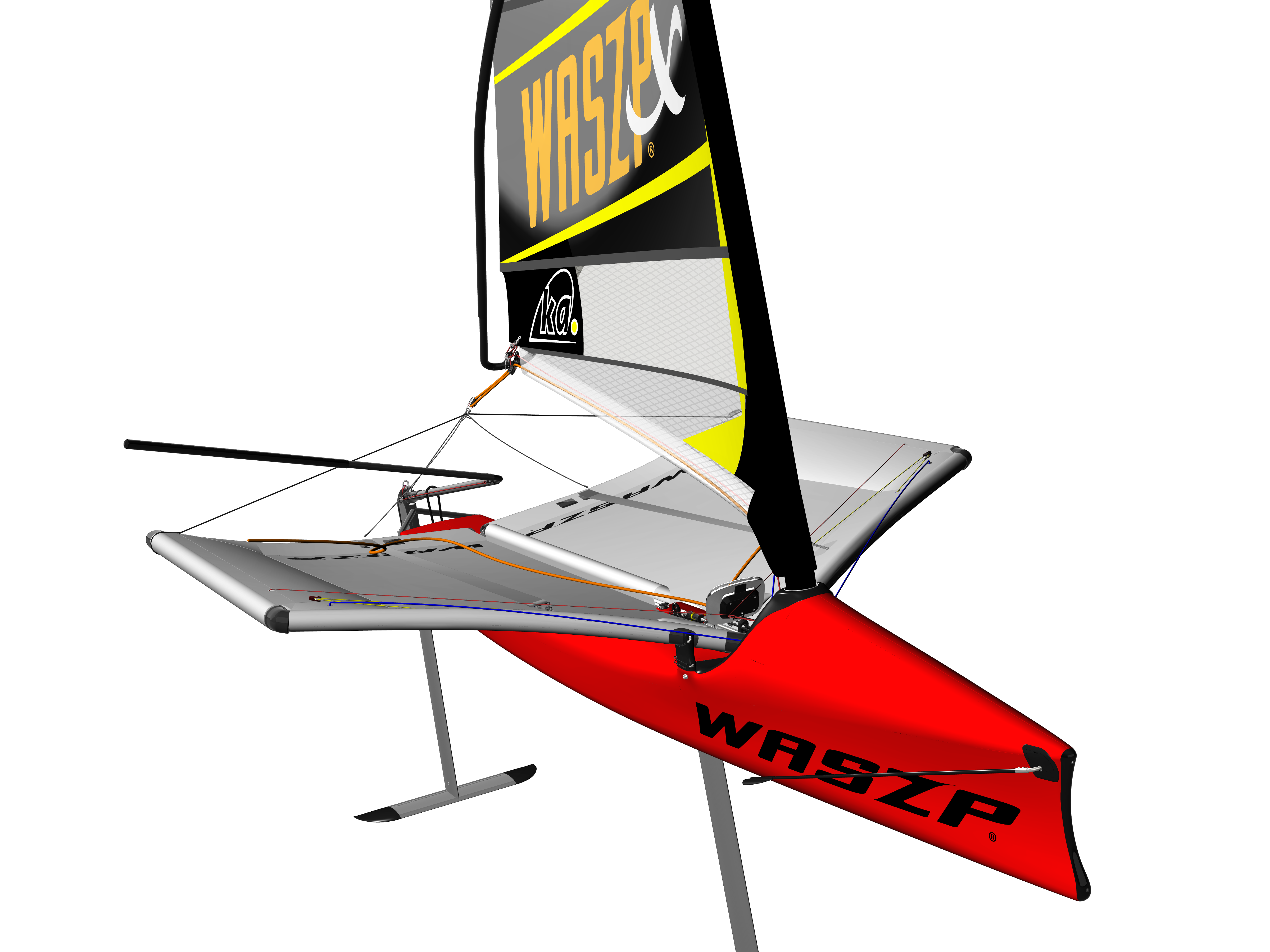
Showroom Pathway SailGP News
Webshop Documents Ask WASZP Privacy Policy
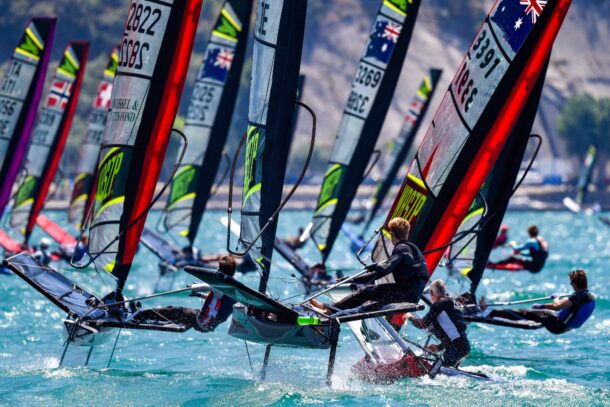
Subscribe to our mailing list and stay up-to-date with the most recent news and updates from WASZP
You have Successfully Subscribed!

Service Locator
- Angler Endorsement
- Boat Towing Coverage
- Mechanical Breakdown
- Insurance Requirements in Mexico
- Agreed Hull Value
- Actual Cash Value
- Liability Only
- Insurance Payment Options
- Claims Information
- Towing Service Agreement
- Membership Plans
- Boat Show Tickets
- BoatUS Boats For Sale
- Membership Payment Options
- Consumer Affairs
- Boat Documentation Requirements
- Installation Instructions
- Shipping & Handling Information
- Contact Boat Lettering
- End User Agreement
- Frequently Asked Questions
- Vessel Documentation
- BoatUS Foundation
- Government Affairs
- Powercruisers
- Buying & Selling Advice
- Maintenance
- Tow Vehicles
- Make & Create
- Makeovers & Refitting
- Accessories
- Electronics
- Skills, Tips, Tools
- Spring Preparation
- Winterization
- Boaters’ Rights
- Environment & Clean Water
- Boat Safety
- Navigational Hazards
- Personal Safety
- Batteries & Onboard Power
- Motors, Engines, Propulsion
- Books & Movies
- Cockpit Confessions
- Communication & Etiquette
- Contests & Sweepstakes
- Colleges & Tech Schools
- Food, Drink, Entertainment
- New To Boating
- Travel & Destinations
- Watersports
- Anchors & Anchoring
- Boat Handling
- ← Technology
Hydrofoils: Boats That Fly
Advertisement
Hydrofoils make everything from water skis to sailboats to giant ferries faster (much faster). But how the heck do they work?
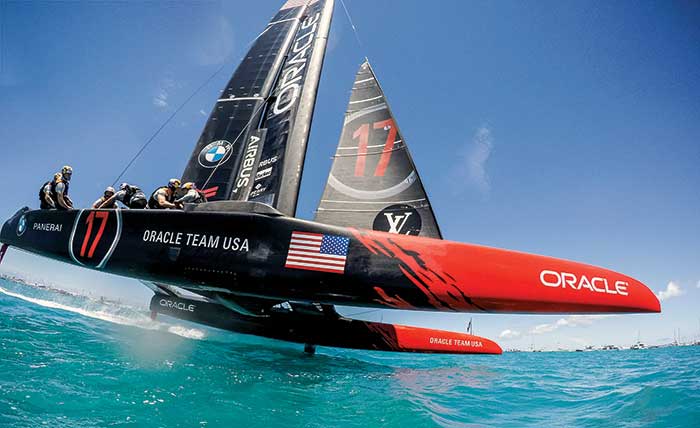
Oracle Team USA's AC50 "flying" at nearly 50 mph. (Photo: Ricardo Pinto)
Ever wonder why a sleek, powerful recreational boat is not even as fast as a typical economy car? It has to do with friction. An economy car needs a little over 100 horsepower to speed by at 100 mph, but pushing a boat through the water that fast takes several hundred horsepower. The reason is that water is almost 800 times denser than air.
Imagine standing on your dock in a 10-knot wind — it's not hard to do. Now imagine being in a river trying to stand up to a 10-knot current. The water is so much denser that no matter how strong you are, you'd be swept away. A boat hull has to push through all that dense water while a car can slip through the air much easier.
Planing boats are able to go faster than displacement boats because they lift part of their hull out of the water as they race over their bow wave, but there's still a lot of friction from the water on the rest of the hull. If you could get the hull all the way out of the water, you'd eliminate that friction, and the boat could go faster with the same amount of power.
The Science
Most of us have a pretty good understanding of how an airplane flies. As air flows over and under the wings (also called airfoils), it creates lift. Once an airplane is going fast enough, the lift that the wings create allow it to rise above the earth.
If you were to mount a wing or two (called hydrofoils) under a boat, all that dense water can be put to good use by pushing the boat's hull out of the water. Then friction only acts on the small foils, not on the whole hull, which is why a 130-foot hydrofoiling sailboat can "fly" at over 50 knots. Powerboats have added friction from the propulsion system that has to remain in the water, but even then, large hydrofoiling ferries can exceed 45 knots.
Speed is not the only advantage that hydrofoils give boats. Because the hull is out of the water, all the energy from waves that would normally pound against the boat pass harmlessly underneath it, creating an eerily smooth ride. Even so, hydrofoiling is typically best in somewhat protected waters.
Don't look for hydrofoils on your next runabout anytime soon because they're much more difficult to engineer and typically triple the cost of a boat. The good news is that there are other ways to 'foil that are affordable — see "Experience Hydrofoiling For Yourself" at below.
Experience Hydrofoiling For Yourself
Hydrofoil kiteboards.
If you've even seen a kiteboard zooming in a strong breeze, you know they're plenty fast. Add a hydrofoil, and suddenly you add a new dimension. These boards take lots of skill and practice to master, but the ride is said to be much smoother and even faster than a conventional kiteboard. Cost starts at around $1,000.
Hydrofoil Waterskis
These single-ski hydrofoils are really a sit-on-ski, and once you've mastered the technique, the foils will lift you up and you'll be "flying." Unlike conventional skis, these aren't designed for speed, and 18 mph is where they typically "liftoff' and suggested top speed is about 25 mph. It's also important not to ski in shallow water due to the depth of the foils. Cost is typically $1,500 and up.
Hydrofoil Windsurfers
Not content to take a surfboard and add a sail, windsurfers developed foils that allow the board to "levitate." The biggest advantage is the smoothness of the ride — a real benefit because these rigs usually sail in very strong winds with plenty of chop. Cost is about $2,500 to get started.
Hydrofoiling Small Sailboats
You don't have to spend millions on a boat like the America's Cup racers if you want to hydrofoil. The Waszp costs about $10,000, though even for dinghy racers, there's a learning curve to get these boats on their foils, with speeds up to 27 mph.
Note that most companies suggest wearing a helmet when using foiling products because of the speeds achievable and the hard, sharp foils these devices have.
Foiling The Competition
America's Cup boats are often what people think of when they hear the word "hydrofoil." Hal Youngren, an aeronautical engineer and one of the designers for the 2013 and 2017 America's Cup racers, says the difference in speed that foils make is impressive. The fastest nonfoiling catamarans in previous races could barely reach 35 knots, while the 2017 foiling cats hit 50 knots. Youngren says that these 50-foot cats are able to lift their hulls completely out of the water using only about three-quarters of a square meter of foil area (about the size of a medium-sized TV). Below about 15 knots, he says, the boats sail much like a nonfoiling boat with hulls in the water, but once over that speed, the boats start to "fly" and their speed dramatically increases.
The America's Cup Class AC75 Boat Concept Revealed
An exciting new era in America's Cup racing was unveiled in November 2017 as the concept for the AC75, the class of boat to be sailed in the 36th America's Cup is released illustrating a bold and modern vision for high performance fully foiling monohull racing yachts.
The America's Cup AC75 Boat Concept Revealed
The Emirates Team New Zealand and Luna Rossa design teams spent the previous four months evaluating a wide range of monohull concepts. Their goals have been to design a class that will be challenging and demanding to sail, rewarding the top level of skill for the crews; this concept could become the future of racing and even cruising monohulls beyond the America's Cup.
The AC75 combines extremely high-performance sailing and great match racing with the safety of a boat that can right itself in the event of a capsize. The groundbreaking concept is achieved through the use of twin canting T-foils, ballasted to provide righting-moment when sailing, and roll stability at low speed.
An underlying principle has been to provide affordable and sustainable technology "trickle down" to other sailing classes and yachts. While recent America's Cup multihulls have benefitted from the power and control of rigid wing sails, there has been no transfer of this technology to the rigs of other sailing classes. In tandem with the innovations of the foiling system, Emirates Team New Zealand and Luna Rossa are investigating a number of possible innovations for the AC75's rig, with the requirement that the rig need not be craned in and out each day. This research work is ongoing as different concepts are evaluated, and details will be released with the AC75 Class Rule before March 31, 2018.
The America's Cup is a match race and creating a class that will provide challenging match racing has been the goal from the start. The AC75 will foil-tack and foil-gybe with only small maneuvering losses, and given the speed and the ease at which the boats can turn the classic pre-starts of the America's Cup are set to make an exciting comeback. Sail handling will also become important, with cross-overs to code zero sails in light wind conditions.
A huge number of ideas have been considered in the quest to define a class that will be extremely exciting to sail and provide great match racing, but the final decision was an easy one: the concept being announced was a clear winner, and both teams are eager to be introducing the AC75 for the 36th America's Cup in 2021. — AmericasCup.com
Related Articles
The truth about ceramic coatings for boats.
Our editor investigates the marketing claims of consumer-grade ceramic coatings.
Fine-Tune Your Side Scan Fishfinder
Take your side-scanning fishfinder off auto mode, and you’ll be spotting your prey from afar in no time
DIY Boat Foam Decking
Closed-cell foam flooring helps make boating more comfortable. Here’s how to install it on your vessel
Click to explore related articles
Charles Fort
Contributing Editor, BoatUS Magazine
Charles Fort is BoatUS Magazine's West Coast Editor. He often writes local news items for BoatUS Magazine's Waypoints column and contributes to Reports, in-depth tech features in every issue written to help readers avoid accidental damage to their boats. He is a member of the National Association of Marine Surveyors, he's on ABYC tech committees, and has a 100-ton U.S. Coast Guard license. He lives in California.
BoatUS Magazine Is A Benefit Of BoatUS Membership
Membership Benefits Include:
Subscription to the print version of BoatUS Magazine
4% back on purchases from West Marine stores or online at WestMarine.com
Discounts on fuel, transient slips, repairs and more at over 1,200 businesses
Deals on cruises, charters, car rentals, hotel stays and more…
All for only $25/year!
We use cookies to enhance your visit to our website and to improve your experience. By continuing to use our website, you’re agreeing to our cookie policy.
SuperFoiler Grand Prix is the ‘F1’ of hydrofoil sail-racing. There is no other entertainment product like it in the world.
The SuperFoiler is a highly advanced, purpose-built machine that drives unrivalled performance.
The world’s best sailors agree that our IP and ambition exemplify leadership in the new combined dimension that is flying and sailing.
Our aim is to deliver dynamic racing, create rich content as well as develop new on and off- water experiences.
"The difficulty, the speed, the trapeze, these challenges draw the world's best sailors. The SuperFoiler Grand Prix is not for the faint hearted!"
With a crew of three, communication and courage will be the key to these machines.
About the Teams
SuperFoiler brings together aerodynamics and hydrodynamic excellence to create the fastest foil-borne machine of its size on the planet.
About SuperFoiler
We're social
Connect and engage with us to keep up to date!
- --> YouTube
Our Partners Find out more

F1x A-class foiling catamaran
World champion, lighter = better, craftsmanship, meet the foiling f1x a-class catamaran.
This is the ultimate singlehanded foiling catamaran of the moment: ultramodern, incredibly fast, very agile, extremely strong and feather-light, in an aerodynamic and ergonomic design. The perfect total package, packed in 1 foiling catamaran. This is the world’s coolest boat for singlehanded races and the winner of several A-cat world championships and many other sailing races.
The 2020-F1x A-cat is exactly the same foiling catamaran that made Mischa Heemskerk Vice-World Champion at the Herveybay Worlds 2018 in Australia and World Champion at Weymouth 2019. All our foiling F1x A-class catamarans come straight, ready to race and ‘Mischa-tuned’ from our factory.
Unique design enables top performances
The F1x A-class foiling catamaran is the ultimate reflection of our current design language. The aerodynamic design accentuates the performance qualities of this super fast foiling racing boat. The sophisticated deck plan provides clear control and minimal air resistance.
Foils The rudders and daggerboard foils used on the F1x A-class foiling catamarans are produced with the highest quality carbon pre-preg fibers. The foils are cured in our own Autoclave . Our winning foil design was created in close cooperation with Glenn Ashby and the designers of AC Team New Zealand .
Construction The F1x A-cat is manufactured entirely according to the carbon pre-preg/ Nomex production method, and cured in our Autoclave. This technology is the same as used in the aerospace industry and within other foiling boats like for example, the America’s Cup.
Design The design of the F1x foiling A-class catamaran was completely conceived by the DNA design team and made at DNA’s own yard. In the DNA design team Pieterjan Dwarshuis, Mischa Heemskerk and the renowned Dutch industrial design engineer Rudo Enserink worked closely together to create the perfect foiling A-class catamaran.
We build your new foiling boat!
Technical details.
The F1x A-class foiling catamaran has a number of unique features that improve performance. For example:
- Semi ridged trampoline. Gives extra torsional stiffness to the boat and increases its aerodynamic characteristics.
- Patented main-sheet-wheel-system. For more direct and faster trim of the main sail.
- Aerodynamically placed traveller car.
- Flexible daggerboard casings. For minimal water absorption in floating mode.
- Aerodynamically shaped ‘beams’.
- Adjustable T-rudders. Foiling with rudder differential is possible.
Specifications
LOA: 5.49 m BOA: 2.30 m Max. draught: 1.20 m Sail area: 13.94 m Total weight: ca. 53 kg Top speed: 31 kn Extra: All measurements according to IACA Class regulations.
Buy a champion's boat!
Are you excited to buy a F1x A-class foiling catamaran from DNA Performance Sailing? Please fill in our contact form:
Yes, I want a F1x A-cat!
Schrijf je in voor onze nieuwsbrief en blijf op de hoogte van de nieuwste ontwikkelingen.
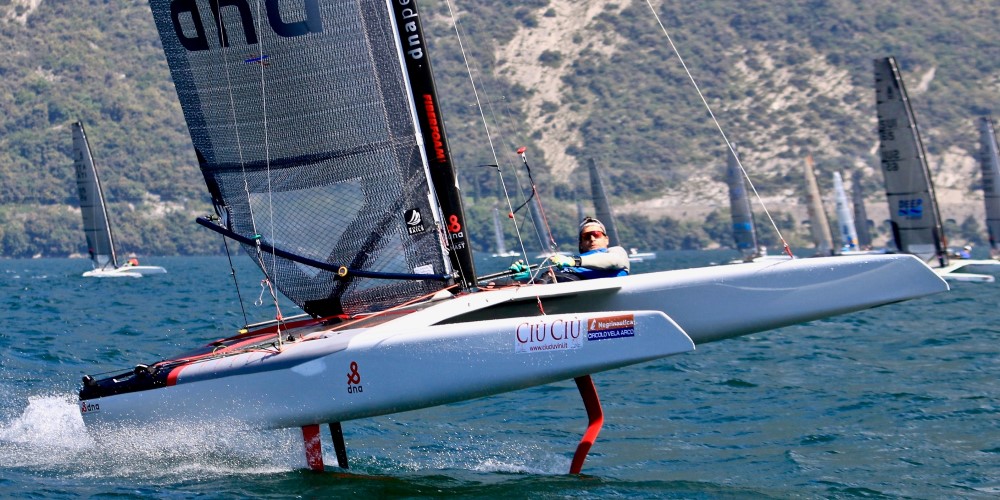
Contactformulier
- Company Name
- Full name * First Last
- Emailaddress *
- Phonenumber *
- Mijn vraag betreft * My question: TF10 F1x G4 F4 Custom Parts Hydrofoils Other
- Name This field is for validation purposes and should be left unchanged.
Registrieren Sie sich für unseren Newsletter
lassen Sie sich über die neuesten Entwicklungen informieren!
- E-Mail-Adresse *
- Comments This field is for validation purposes and should be left unchanged.
Schrijf je in voor onze nieuwsbrief
blijf op de hoogte van de nieuwste ontwikkelingen!
- First name *
- Last name *
- Email This field is for validation purposes and should be left unchanged.
Wij gebruiken cookies om u de beste online ervaring te bieden. Door akkoord te gaan, accepteert u het gebruik van cookies in overeenstemming met ons cookiebeleid.
Wanneer u een website bezoekt, kan deze informatie in uw browser opslaan of ophalen, meestal in de vorm van cookies. Beheer hier uw persoonlijke cookiediensten.
- wordpress_test_cookie
- wordpress_logged_in_
- wordpress_sec

- FlySafe ® Foil Control
- iFLY Reviews
- Our Partners
- Distributors
- Class Association
Enter your keyword

“iFLY15 is the unique combination of high performance with easy accessibility – for maximum performance and maximum fun.”
Cec catamarans -ifly15 team, “we love speed while keeping control – high speed needs to be controllable. the flying boat of the future, is a stable foiling sport catamaran.”, cec catamarans – ifly15 team, „ foiling: one of the things you have to experience to really feel it. “, jimmy spithill, skipper oracle team usa, “stable flight is the key to high performance sailing”, “ifly15 – get the balance right between a nice sporting challenge and a reasonable and controllable level – enjoy the exhilaration, the speed and the adrenaline in your veins, but always stay master of the situation “, “stable flight attitude is the most important prerequisite for high performance sailing.”, victor diaz de leon, sailgp team usa, “stable flight attitude is key for easy foiling. ifly15 with superior flight stability delivers immediate flying fun within the first minutes. advantage through high-tech.”, “the ifly15 is the quickest boat around the course, … “, arno terra – sailor, ifly 15 one design and ifly razzor pro, the performance foiling catamaran, for maximum speed and maximum control.
- Easy access to a high HIGH PERFORMANCE FOILING CATAMARAN
- Automated DYNAMIC FLIGHT Assistance SYSTEM – FLYSAFE® FOIL CONTROL
- highest quality standards – High-tech full carbon sailboat
- completely modular – fully customizable
- adjustable rake – MAIN FOIL DIFFERENTIAL during sailing for even more performance in the version IFLY Razzor Pro
- Foiling Versatility and Speed …
The quality and performance have been proven for 8 years and further developed to maximum perfection in every detail
IFLY HYDROFOIL SAILING – EXCELLENCE, FIELD PROVEN TO PERFECTION
Racing and more …..
Have a high performance racing machine on regattas
single handed or double Foiling
crew weight up to 180 kg
Racing and fun:
Sail with Family & friends
in any sailing condition:
Full foiling – upwind and downwind
Waves and Flat waters
Light and strong winds
early take off
Foiling maneuvers
Transport and Facilities
Easily transportable on a road trailer
Slipped with a conventional beach trolley
ready to sail in 20 minutes
iFLY15 is designed to sail on the sea and lakes
Stay tuned for foiling events and specials!
Flysafe® Flight assistance
Main foil differential technology – mdt, innovative, sophisticated foil control for unbeaten performance, high speeds and easy access, ifly15 and ifly razzor pro, ifly main foil differential – mdt, ifly razzor pro.
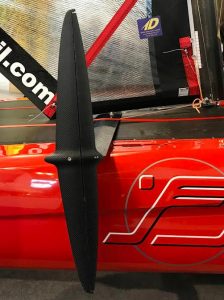
early take off in lightest breeze
F oiling maneuvers are heavily supported, superior flight attitude through active foil control, dynamic control of f light high , pitch and role, non-linear control and feedback control system for best flight stability, even in waves, the foils do not need to be manually manipulated, optimized performance: advanced sailors can adjust rake and gearing, more about flysafe®>>>, active flight assistance, the foil can be trimmed actively while sailing, the key to maximum performance , mdt for performance-orientated pro sailor, mdt extends the flysafe® foil control, to sail large xxl rigs, more about main foil differential ->>>, performance downwind: staying on the foils, full foiling, in 5-6kts tws, reaching max. boat speeds of up to 2.5*tws, performance upwind: full foiling from 8kts. tws, taking off from 7kts tws, video youtube channel, ifly15 foiling catamaran.

The most innovative development in foiling technology
About ifly15, stable flight is key for both: first for highest performance and foiling in a wide wind range, including rough and wavy conditions, but also easy access into foiling…...
iFLY stands for uniqueness in design and function. Its superior Flysafe ® active foil control system autonomously supports the stable horizontal flight position in the longitudinal and lateral direction. The 4 T-Foils do not have to be operated by the sailor during sailing.
Average skilled dinghy or catamaran sailors with some trapeze experience can safely foil with the iFLY15 after only a few hours. Quick access – the immediate sensation of success – steep learning curve. In the hand of an experienced sailor, iFLY15 offers a whole new sailing experience with previously not experienced speeds and agile maneuverability.
The flight control system, combined with numerous fine-tuned innovations , ensures safe foiling even in strong winds and rough seas.. Stable flight attitude allows pushing hard, so in good conditions, iFLY reaches high boat speed beyond 30 knots in a controllable way.
IFLY15 offers freedom to fly alone or in pairs. Due to the exclusive use of high-tech materials , iFLY15 is extremely rigid and weighs less than 90 kilos ready to sail. With its low weight and its state-of-the-art hydrofoils, it is airborne in winds as low as 2Bft. / 6 Knots.
iFLY15 has a length of only 15 feet, is easy to transport, quick to get ready to sail, and can be easily slipped from the beach using a conventional beach trolley.
Its sophisticated design reflects the highest demands on quality and function.
iFLY15 – customer reviews
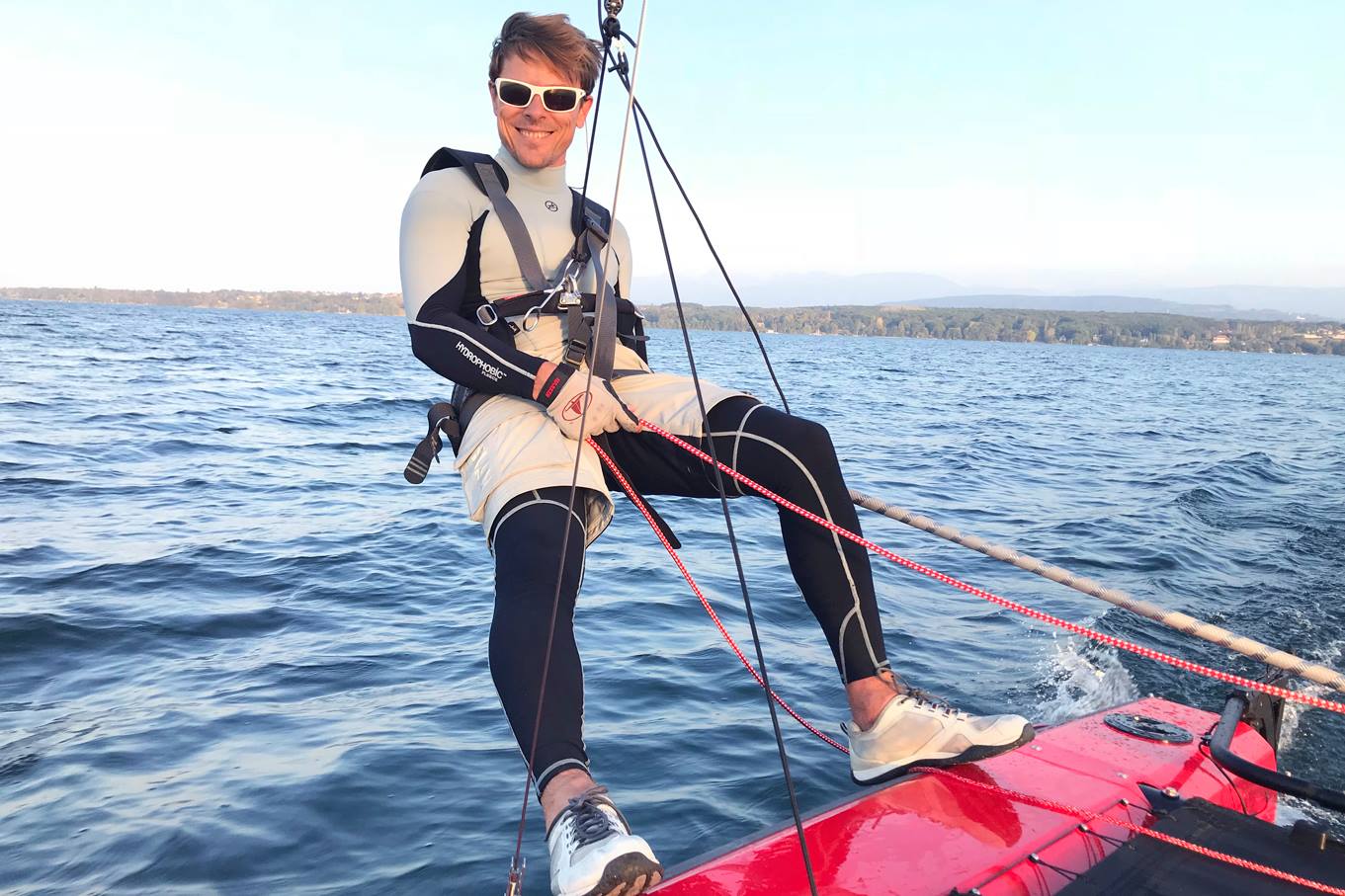
« LESS CRASHING IS MORE FUN »
MARCUS LYNCH, PROFESSIONAL SAILOR AND OLYMPIC COACH, GC32 OMAN, NACRA17
« I WAS INITIALLY AMAZED AT HOW EASY TO HANDLE THE IFLY IS AND AT HOW IDLE THE BOAT IS EVEN IN STRONG WINDS. »
ANTOINE, IFLY OWNER FROM GENEVA
VERY STABLE, EXTRAORDINARY STABLE. IT IS EXTREMELY INTERESTING, BECAUSE YOU IMMEDIATELY SEE THE ACCESSIBILITY OF THE BOAT.
FRANÇOIS GABART
« GREAT BOAT, LIKE A MOTH ON STEROIDS ! »
VICTOR DIAZ DE LEON, MIAMI, PROFESSIONAL SAILOR. US TEAM SAILGP, INTERNATIONAL MOTH, MATCHRACING MELGES 32, J70
WHAT A GREAT BOAT THIS IS, AND I ABSOLUTELY LOVE IT”
PHILIP WALKER
« THE DYNAMIC FLIGHT CONTROL SYSTEM ALLOWS LONG AND STABLE FLIGHTS »
GERHARD FLORIN, IFLY OWNER FROM GENEVA, SWITZERLAND
TO FELLOW SAILORS WHO LOVE THE THRILL OF SAILING WITH SPEED WHILE MAINTAINING CONTROL”
ROY BALLENTINE
« WELL BALANCED AND RAKE DIFFERENTIAL ALLOWING FOR GREAT PERFORMANCE UPWIND! »
CARLOS ROBLES,PROFESSIONAL SAILOR 49ER, PALMA DE MALLORCA
« A SENSATIONAL FOILING EXPERIENCE. THE SPEED IS IMPRESSIVE »
INGMAR WARNICKE: COMMODORE OF YCSO, YACHT CLUB SCHARBEUTZ, BALTIC SEA
⭐ ⭐ ⭐ ⭐ ⭐

IFLY RAZZOR PRO – THE NEW IFLY FOR EXPERIENCED SAILORS
THE SINCE 7 YEARS PROVEN IFLY15 WITH FLYSAFE® DYNMAMIC FOIL CONTROL has now a pur Racing fellow: THE iFLY RAZZOR Pro. THE iFLY racing VERSION ENABLES EVEN HIGHER PERFORMANCE, to sail in extremely tough conditions and allows sailing with XXL rigs. THE MAIN DIFFERENCE BETWEEN THE IFLY15 ONE DESIGN AND THE IFLY RAZZOR PRO IS A BIGGER RACING RIG, SPECIAL FOILS AND THE MAIN FOIL DIFFERENTIAL (MDT), WHICH IS MANUALLY TRIMMED BY THE SAILOR. THE MDT IS WORKING HAND IN HAND WITH THE FLYSAFE® DYNAMIC FOIL CONTROL SYSTEM.
flying – sailing – Blog

ROUND TEXEL RACE 2024
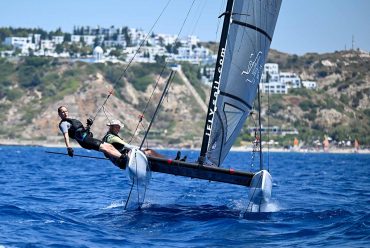
“We’re taking off! Foiling is THE Watersports Trend! – „Boot International 2024“ in Düsseldorf / Germany once again showcases: Foiling is THE trend in watersports.
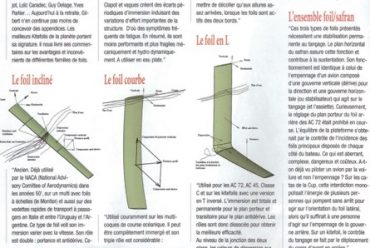
Performance Sailing – Sail GP News: Racing on the Edge – T-Foil proves to be the winning design

Regatta and foiling News: Long distance Race – Duc d’Albe 2023 – Club Multicoques Hyères – sailing Race @iFLY Razzor Pro
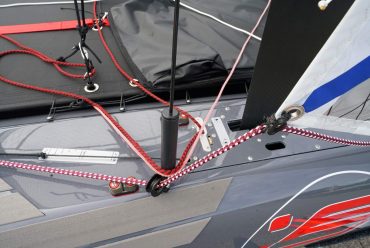
iFLY Main Foil Differential Technology – MDT Foil Control – high Performance sailing
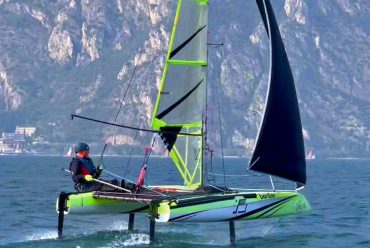
IFLY FOILING Adventure
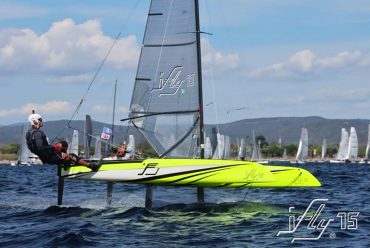
FOILING – REGATTA – EVENTS
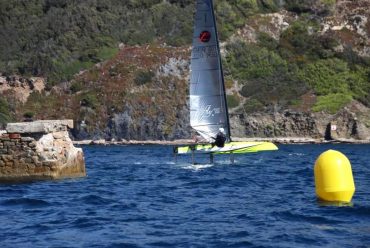
Long distance Race – Duc d’Albe 2021 – Club Multicoques Hyères – sailing Race @iFLY Razzor Pro
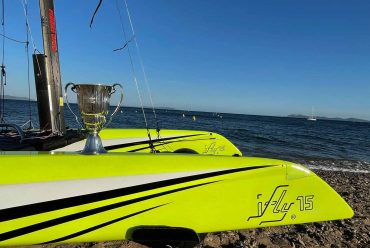
INTERNATIONAL IFLY foiling FLEET RACE 2021
Catamaran europe central, the iflysail team, is looking forward to your message.

COMMENTS
Offhsore, 90ft Ultime multihulls on their foils are competing to be the fastest to race around the globe and design houses across the globe are racing to create foiling yachts for the masses which ...
The first issue is how much foil surface area you need to lift the boat. This varies with speed: the faster you go, the less you need. Early foil design used ladder-type racks of foils which ...
The history of foiling. The early development of hydrofoils started over 100 years ago when Italian Enrico Forlanini achieved 36.9 knots with his 60hp airscrew-driven boat in 1906. Several ...
Do you want to see the fastest and most thrilling sailing competition in the world? Watch the high speed hydrofoil racing of Red Bull Foiling Generation, where young sailors fly above the water on ...
With razor-sharp hydrofoil catamarans that help them hit speeds of 60 miles an hour, the athletes of SailGP are pushing the limits of physics and human endur...
This January sees a new pinnacle-of-pinnacles event: the first solo, non-stop, round the world race in Ultim trimarans. Six brave French skippers on their 100ft multihulls are entered. The ...
It was August 2012 when the sailing world was turned upside down by a 72- foot catamaran flying in the Hauraki Gulf. Emirates Team New Zealand had brought foils to the America's Cup, changing the face of top-level yacht racing forever. Six years later, in 2018, the publication of the AC75 Class Rule marked the beginning of a new sailing era.
Hydrofoil yachts use foils to lift the hull out of the water, reducing drag and increasing speed. Different types of foils, such as T foils, C foils, S foils, and L foils, are used for stability and control. ... Hydrofoil racing yachts can achieve impressive speeds, with some models reaching over 50 knots (57.5 mph or 92.6 km/h). The F50 ...
Patriot, the just-launched America's Cup racing yacht representing the United States, ... Organizers supply some parts of the boat, including the mast, rigging, foil-cant arms and hydraulics ...
These angles close as the boat sails and the foil is loaded up to become much closer to, or 90 degrees. ... America's Cup Clipper Round the World Yacht Race College Sailing COVID-19 Craig Leweck ...
Jul 22, 2024. Original: Nov 30, 2018. With the TF10, big-boat multihull foiling is now available to amateurs as well as pros. Any time I put a helmet on I become hyper-aware of every step I take. Precaution means there's an alternative to a happy ending. On one of my last rides of the 2018 summer season, the helmet was mandatory, as was the ...
What sounds like a jet overhead is actually the boat responding as the 15-knot gusts hit the "wings"—the stiff 95-foot-high sails designed as airfoils—and the 50-foot cat accelerates to ...
Port and starboard moveable appendage arms and foils are needed to achieve and sustain flying performance on both tacks. A T-shaped foiling rudder keeps the boat in proper angle of attack trim for the foils to lift, as well as to steer the boat in both displacement and flying modes.
In SailGP, five-member crews representing six countries race identical F50 foiling catamarans in the world's most famous harbours. Complex control systems an...
SEAir foiling RIB. Founded in 2016, French yard SEAir builds foiling RIBs, having been inspired by the speed of foiling racing yachts. We tested their 5.5m model back in 2018 and since then they have expanded their range to cover superyacht chase boats, commercial and military vessels.. Our tester recorded a top speed of 32 knots, with the foils doing their best work at around 20 knots, but ...
Look back to last December's Sydney-Hobart race, and remember how the 10-year-old maxi Wild Oats XI trounced the brand new Comanche, the world's most technically advanced—and probably most expensive—racing yacht.The Australian boat had just been fitted with its DSS foil, which tracks athwartships in a cassette below the waterline and is deployed to leeward.
10. New Zealand 'R' Class skiff. In New Zealand they love their skiff sailing, and development classes like the doublehanded 'R' Class are prime for new features. The 'R' Class started its project to get the fleet foiling back in 2008 and now there are a clutch of boats racing.
Mar 4, 2024. Original: Apr 13, 2017. Although still in development, the Beneteau Figaro 3 represents the cutting edge of production foiing monohull design. Image Courtesy of Beneteau. Examining Vendée Globe boats on the dock in Les Sables d'Olonne prior to the start of the race last November, one thing was perfectly clear: the genie is out ...
The system is based on a horizontal foil that is deployed on the leeward side. As the boat picks up speed, the foil produces vertical lift, which increases the righting moment of the boat and ...
It was August 2012 when the sailing world was turned upside down by a 72-foot catamaran flying in the Hauraki Gulf. Emirates Team New Zealand had brought foils to the America's Cup, changing the face of top-level yacht racing forever. Six years later, in 2018, the publication of the AC75 Class Rule marked the beginning of a new sailing era.
As a development class, the IMOCA rule gives designers plenty of scope for innovation and creativity - as evidenced by the hull designs of the five participating yachts in The Ocean Race 2022-23. France's three best known yacht designers - either working alone, or in collaboration with each other - are responsible for all five of these ...
It is important to realise that the foils on boats work differently: They do not push the boat out of the water, but pull it in, keeping it in the water. In both the Sailrocket and the kite models, the sail pulls the boat strongly upwards. This means that the foil guarantees contact with the water.
Just wow. I don't even know where to begin! To say that last week was one of the best weeks of my life would be an understatement. It'll change your life, a 30 minute test ride led to the most fun 3 years I've ever had! World-class foiling has never been easier. The WASZP is the perfect platform for enjoying one-design racing and a fun ...
The AC75 combines extremely high-performance sailing and great match racing with the safety of a boat that can right itself in the event of a capsize. The groundbreaking concept is achieved through the use of twin canting T-foils, ballasted to provide righting-moment when sailing, and roll stability at low speed.
More news. SuperFoiler Grand Prix is the 'F1' of hydrofoil sail-racing. There is no other entertainment product like it in the world. The SuperFoiler is a highly advanced, purpose-built machine that drives unrivalled performance. The world's best sailors agree that our IP and ambition exemplify leadership in the new combined dimension ...
Sailing hydrofoil. A sailing hydrofoil, hydrofoil sailboat, or hydrosail is a sailboat with wing-like foils mounted under the hull. As the craft increases its speed the hydrofoils lift the hull up and out of the water, greatly reducing wetted area, resulting in decreased drag and increased speed. A sailing hydrofoil can achieve speeds exceeding ...
Unique design enables top performances. The F1x A-class foiling catamaran is the ultimate reflection of our current design language. The aerodynamic design accentuates the performance qualities of this super fast foiling racing boat. The sophisticated deck plan provides clear control and minimal air resistance. The rudders and daggerboard foils ...
the flying boat of the future, is a stable foiling sport catamaran." ... the main difference between the ifly15 one design and the ifly razzor pro is a bigger racing rig, special foils and the main foil differential (mdt), which is manually trimmed by the sailor. the mdt is working hand in hand with the flysafe® dynamic foil control system.